E.G. Wolverson's Blog, page 7
October 29, 2018
TV Review | Doctor Who: “Arachnids in the UK” by Chris Chibnall
We’ve come a long way since Metebelis III. The first
Doctor Who
story in a staggering forty-four years to feature giant arachnids as its monster of the week dazzles in just about every respect, despite not having a great blue crystal anywhere in sight.
Fulfilling the “Aliens of London” function in this brave new era’s burgeoning native, “Arachnids in the UK” sees the Doctor return her friends home to their native Sheffield in the present day. There they discover that something has caused the city’s spider population to grow out of control and converge on an unopened hotel that Yaz’s mum - sorry, Najia - is getting set to manage.
Whilst the episode’s ambitious effects leave a lot to be desired - director Sallie Aprahamian might have considered taking a leaf from The X-Files ’ playbook and using far less light in some of the more effects-heavy sequences - any visual shortcomings are made up for by Chris Chibnall’s scintillating script. Like many of the series’ finest offerings, “Arachnids in the UK” is as fast and as funny as it is unsettling. Yet such qualities belie the aching pathos at the story’s heart; I’ve heard of sympathy for the Devil, but sympathy for a spider? Thirty-seven seasons in and Doctor Who still continues to astound with its innovation.
Chibnall’s plot is the season’s most sophisticated so far. Impossible to predict but thoroughly rewarding in its payoff, “Arachnids in the UK” eschews the series’ reliance on extra-terrestrial threats to the planet and instead serves as the series’ most scathing ecological commentary since “The Green Death” of 1973. The writer doesn’t limit his social commentary to conservation concerns, though - the character of Robertson, for instance, who’s magnificently realised by Chris “Mr Big” Noth (yes – I’ve seen almost every episode of Sex and the City, just as the missus has sat through most episodes of modern Doctor Who), is a harrowing reflection of those with power and wealth today. What’s particularly funny – in the unsettling sense of the word – about the character is that at a first glance he’s every bit the loathsome, larger-than-life human foil that we’ve seen so many times before in Doctor Who, but then you realise: there’s no such thing anymore, life really is that large now. Robertson might be planning to run against Trump in the 2020 election (should Trump make it that far...), but he’s a representation of him in all but name.
The episode is also a strong character piece for the ensemble, cementing Jodie Whittaker’s Doctor in the role through an enchanting fusion of social awkwardness and gung-ho cool. Gone are the days of the Doctor not doing “domestics” - she throws herself headlong into dinner at Yaz’s here, her patent loneliness turning quickly to exuberant delight. She calls people “dude” now, can do the kookiest of small talk, and is as naively nonchalant about her possible involvement in a same-sex/different species relationship as she is Ed Sheeran’s identity.
And this week it’s also Yaz’s turn to shine. For the first time, we see her character in context, surrounded by her family. She’s not just the ambitious, downtrodden trainee police officer we saw in “The Woman Who Fell to Earth”; she’s also a daughter and a big sister, and so we get to see her trying to reconcile those roles with her new one as a time-travelling adventurer. It’s a wonderful dynamic; the back and forth with her mum (Shobna Gulati of Corrie fame) is particularly arresting.
The men take a bit of backseat, in contrast, though the script does check in with Ryan a few times - usually for action sequences - and we start to explore Graham’s grief in earnest. Chibnall presents us with a wonderfully moving and ambiguous sequence that could just as easily be a moving character moment, the prelude to a spooky story later in the season, or perhaps even both. I do think more needs to be made of Ryan’s dyspraxia, though - it’s not been mentioned in a couple of weeks despite the character needing to do some really quite coordinated stuff. Surely catching and securing a giant spider is on a par with riding a bike? I’m no expert, of course, but that’s kind of the point - I was expecting to be by four episodes in, and not just because I’ve done my due diligence on Wikipedia.
Overall, though, “Arachnids in the UK” is another hit for what is fast becoming, once again, a hit series, and I await Team TARDIS’s first voyage into the future with bated breath.
Fulfilling the “Aliens of London” function in this brave new era’s burgeoning native, “Arachnids in the UK” sees the Doctor return her friends home to their native Sheffield in the present day. There they discover that something has caused the city’s spider population to grow out of control and converge on an unopened hotel that Yaz’s mum - sorry, Najia - is getting set to manage.
Whilst the episode’s ambitious effects leave a lot to be desired - director Sallie Aprahamian might have considered taking a leaf from The X-Files ’ playbook and using far less light in some of the more effects-heavy sequences - any visual shortcomings are made up for by Chris Chibnall’s scintillating script. Like many of the series’ finest offerings, “Arachnids in the UK” is as fast and as funny as it is unsettling. Yet such qualities belie the aching pathos at the story’s heart; I’ve heard of sympathy for the Devil, but sympathy for a spider? Thirty-seven seasons in and Doctor Who still continues to astound with its innovation.
Chibnall’s plot is the season’s most sophisticated so far. Impossible to predict but thoroughly rewarding in its payoff, “Arachnids in the UK” eschews the series’ reliance on extra-terrestrial threats to the planet and instead serves as the series’ most scathing ecological commentary since “The Green Death” of 1973. The writer doesn’t limit his social commentary to conservation concerns, though - the character of Robertson, for instance, who’s magnificently realised by Chris “Mr Big” Noth (yes – I’ve seen almost every episode of Sex and the City, just as the missus has sat through most episodes of modern Doctor Who), is a harrowing reflection of those with power and wealth today. What’s particularly funny – in the unsettling sense of the word – about the character is that at a first glance he’s every bit the loathsome, larger-than-life human foil that we’ve seen so many times before in Doctor Who, but then you realise: there’s no such thing anymore, life really is that large now. Robertson might be planning to run against Trump in the 2020 election (should Trump make it that far...), but he’s a representation of him in all but name.
The episode is also a strong character piece for the ensemble, cementing Jodie Whittaker’s Doctor in the role through an enchanting fusion of social awkwardness and gung-ho cool. Gone are the days of the Doctor not doing “domestics” - she throws herself headlong into dinner at Yaz’s here, her patent loneliness turning quickly to exuberant delight. She calls people “dude” now, can do the kookiest of small talk, and is as naively nonchalant about her possible involvement in a same-sex/different species relationship as she is Ed Sheeran’s identity.
And this week it’s also Yaz’s turn to shine. For the first time, we see her character in context, surrounded by her family. She’s not just the ambitious, downtrodden trainee police officer we saw in “The Woman Who Fell to Earth”; she’s also a daughter and a big sister, and so we get to see her trying to reconcile those roles with her new one as a time-travelling adventurer. It’s a wonderful dynamic; the back and forth with her mum (Shobna Gulati of Corrie fame) is particularly arresting.
The men take a bit of backseat, in contrast, though the script does check in with Ryan a few times - usually for action sequences - and we start to explore Graham’s grief in earnest. Chibnall presents us with a wonderfully moving and ambiguous sequence that could just as easily be a moving character moment, the prelude to a spooky story later in the season, or perhaps even both. I do think more needs to be made of Ryan’s dyspraxia, though - it’s not been mentioned in a couple of weeks despite the character needing to do some really quite coordinated stuff. Surely catching and securing a giant spider is on a par with riding a bike? I’m no expert, of course, but that’s kind of the point - I was expecting to be by four episodes in, and not just because I’ve done my due diligence on Wikipedia.
Overall, though, “Arachnids in the UK” is another hit for what is fast becoming, once again, a hit series, and I await Team TARDIS’s first voyage into the future with bated breath.
Published on October 29, 2018 21:50
October 27, 2018
TV Review | Doctor Who: “Rosa” by Malorie Blackman & Chris Chibnall
 Now my knowledge of recent
Doctor Who
is far from encyclopaedic, but I can’t remember the last time that it told a good, old-fashioned historical story. By that I don’t mean an almost exclusively educational piece the like of which half the Hartnell era was built on, nor do I mean the just-happen-to-be-set-in-olden-days capers that we frequently saw during Smith and Capaldi’s tenures. I’m talking about an episode built around a historical icon or event but that doesn’t necessarily eschew the series’ sci-fi staples. A piece that entertains as it educates. A piece that, in this case, even uplifts.
Now my knowledge of recent
Doctor Who
is far from encyclopaedic, but I can’t remember the last time that it told a good, old-fashioned historical story. By that I don’t mean an almost exclusively educational piece the like of which half the Hartnell era was built on, nor do I mean the just-happen-to-be-set-in-olden-days capers that we frequently saw during Smith and Capaldi’s tenures. I’m talking about an episode built around a historical icon or event but that doesn’t necessarily eschew the series’ sci-fi staples. A piece that entertains as it educates. A piece that, in this case, even uplifts.
The series’ first tour de force in years is in fact a deceptively simple tale of intolerance writ large across the ages. Former Children’s Laureate Malorie Blackman and incumbent showrunner Chris Chibnall couch the famous tale of Rosa Parks and her world-changing line-in-the-sand in the classic Who scenario of a rogue time traveller looking to subvert history. But the Devil is in the detail, and though the formula may be familiar, here it is the detail that sets this episode apart. The Doctor and her friends aren’t charged with putting great wars or natural disasters back on track this time – their concern is incredibly focused and specific. Their role in “Rosa” is intimate and mundane, yet still immeasurably important - they just have to make sure that a hard-working and kindly seamstress gets her usual bus, that the bus in question is full, and that its usual despotic driver is behind its wheel.
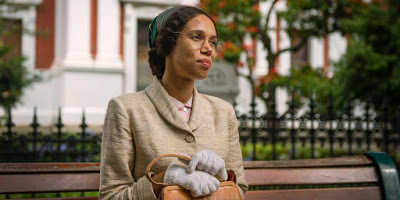 Vinette Robinson, who’s no stranger to Doctor Who, having played Abi in the Chris Chibnall-scripted “42” more than a decade ago, gives a beautifully restrained performance as the put-upon Mrs Parks. The script depicts Rosa as a righteous, God-faring woman - but not one that you would expect to change the course of history, were it not for your foreknowledge. When we meet her, the “coloured” community in Montgomery is still reeling from the murder of Emmett Till (and the acquittal of the two white men who had murdered him), and as the events of the story unfold we see Rosa increasingly tested by the inequality all around her. Robinson brings a sense of weariness to the part that’s unexpected, but really helps to make the character resonate as person as opposed to a pop icon, thus making her fateful act of defiance all the more inspiring.
Vinette Robinson, who’s no stranger to Doctor Who, having played Abi in the Chris Chibnall-scripted “42” more than a decade ago, gives a beautifully restrained performance as the put-upon Mrs Parks. The script depicts Rosa as a righteous, God-faring woman - but not one that you would expect to change the course of history, were it not for your foreknowledge. When we meet her, the “coloured” community in Montgomery is still reeling from the murder of Emmett Till (and the acquittal of the two white men who had murdered him), and as the events of the story unfold we see Rosa increasingly tested by the inequality all around her. Robinson brings a sense of weariness to the part that’s unexpected, but really helps to make the character resonate as person as opposed to a pop icon, thus making her fateful act of defiance all the more inspiring.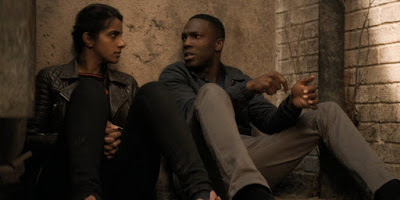 “Never give them the excuse.”
“Never give them the excuse.”The script adroitly serves each member of the Doctor’s “gang” too, affording each the chance to develop. In the cases of Yaz and Ryan, who, thanks to the colour of their skin, find themselves instant social pariahs, “Rosa” gifts each character a fascinating opportunity to reflect on how different their lives would have been had they been born just sixty years earlier. Both are given chance to vocalise their anger at not only the injustice around them, but their continuing struggle in the present day – and, crucially, without it ever coming close to breaking or provoking them. They share stories of narrow-mindedness from 2018 as the institutionalised bigotry of 1955 forces them to hide behind bins, but there is not a moment in the episode when either character fails to rise above the hatred.
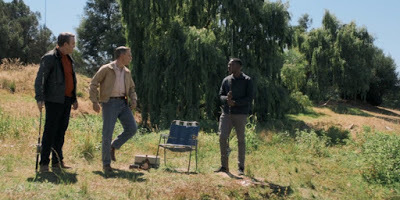
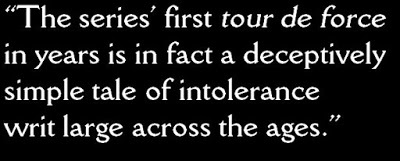 Ryan makes you want to punch the air as he and Graham torment James Blake, the bus driver destined to have Rosa arrested, with their friendly overtures. Yaz makes you smile as she acerbically wrestles with the “Mexican” label foist upon her by a town unable to comprehend her mixed lineage. Even Graham, who is just about the only member of the Doctor’s entourage not to find himself instantly marginalised in 1950s America, isn’t pushed to the sidelines as his bus-driving knowledge, and, indeed, skill, proves pivotal to the plot. As ever, though, even when his presence isn’t directly contributing to the storyline, Bradley Welsh’s comedic delivery and occasional heartbreaking moments of wistfulness threaten to steal the show.
Ryan makes you want to punch the air as he and Graham torment James Blake, the bus driver destined to have Rosa arrested, with their friendly overtures. Yaz makes you smile as she acerbically wrestles with the “Mexican” label foist upon her by a town unable to comprehend her mixed lineage. Even Graham, who is just about the only member of the Doctor’s entourage not to find himself instantly marginalised in 1950s America, isn’t pushed to the sidelines as his bus-driving knowledge, and, indeed, skill, proves pivotal to the plot. As ever, though, even when his presence isn’t directly contributing to the storyline, Bradley Welsh’s comedic delivery and occasional heartbreaking moments of wistfulness threaten to steal the show. 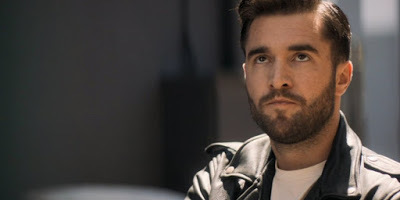 Another strength of the script is its refusal to give the baddie of the piece, Krasko, any sort of motive beyond basic racism. It would have been all too easy for Blackman and Chibnall to paint a picture of a man once hurt or wronged by a “coloured” person and so is now looking for macroscopic revenge, but I find their image of a man who just wants to stop black people ever “getting above themselves” altogether uglier, and altogether bolder. Krasko is exactly the villain that “Rosa” needs, and Joshua Bowman plays the part with just the right sort of smug spite – his permanent, superior sneer and righteous exasperation will be all too familiar to many viewers.
Another strength of the script is its refusal to give the baddie of the piece, Krasko, any sort of motive beyond basic racism. It would have been all too easy for Blackman and Chibnall to paint a picture of a man once hurt or wronged by a “coloured” person and so is now looking for macroscopic revenge, but I find their image of a man who just wants to stop black people ever “getting above themselves” altogether uglier, and altogether bolder. Krasko is exactly the villain that “Rosa” needs, and Joshua Bowman plays the part with just the right sort of smug spite – his permanent, superior sneer and righteous exasperation will be all too familiar to many viewers. 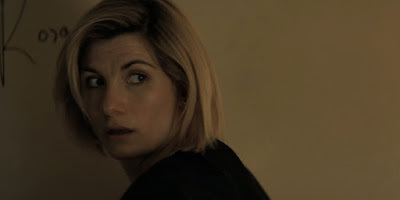
Perhaps most importantly of all, though, the Doctor enjoys what feels like her first full episode as herself. Hyperactive and ultramodern, Thirteen is down with the kids (“You’re killing the vibe, Graham!”), playful (“You’re not Banksy!” / “Or am I?”), and seems to share the second Doctor’s penchant for lulling opponents into a false state of security – her silly, almost ner-ner-ner-ner-ner, sonicing of Krasko as she apparently retreats from him is a case in point. At her core though, she is still the unwavering moral force who will always do what must be done, no matter the personal cost to her. The part that she, Graham and Yaz must ultimately play in Rosa’s story is absolutely gut-wrenching, and Whittaker sells it all with just a few looks. It’s a two-heartsbreaking performance from the series’ leading lady.
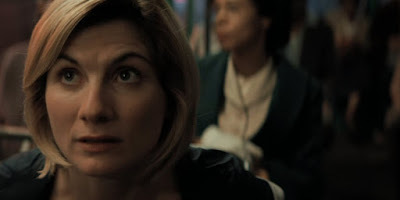 My only minor grumble with what is, undoubtedly, the finest episode of Doctor Who in a decade, concerns the often overbearing nature of Segun Akinola’s score. Admittedly, watching shows like Better Call Saul I’ve becoming accustomed to hearing the drama speak for itself, but particularly with “Rosa” it feels like loud music is – needlessly – trying to dictate how I should be feeling. You’ve got an intimidating looking teddy boy lurking round the TARDIS and stalking Rosa Parks – you don’t need to deafen me with sinister strings to suggest that he’s up to no good. I get it. My six-year-old gets it. It’s there on the screen.
My only minor grumble with what is, undoubtedly, the finest episode of Doctor Who in a decade, concerns the often overbearing nature of Segun Akinola’s score. Admittedly, watching shows like Better Call Saul I’ve becoming accustomed to hearing the drama speak for itself, but particularly with “Rosa” it feels like loud music is – needlessly – trying to dictate how I should be feeling. You’ve got an intimidating looking teddy boy lurking round the TARDIS and stalking Rosa Parks – you don’t need to deafen me with sinister strings to suggest that he’s up to no good. I get it. My six-year-old gets it. It’s there on the screen. 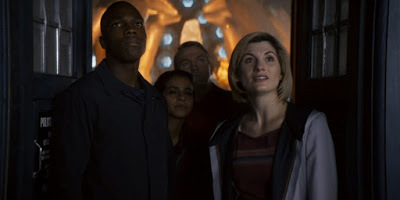
Nonetheless, “Rosa” is an episode that ticks every box. It walks that pixel-thin line between being recognisably Doctor Who, and being something brand new. It’s the first episode of the series that I’ve watched more than once since “The Day of the Doctor”, and on the second viewing it really struck me just how well this season – and this episode in particular – reflects the zeitgeist. Yes, it’s that word again, but for me it encapsulates this new era. Recently I showed my eldest daughter “Rose”, and I could tell from her expressions that it seemed as ancient to her as black-and-white Who did to me as a child. I showed her “Rosa”, though, and she was rapt. Not behind the sofa, but on the edge of it.
If I had any lingering doubts, then “Rosa” crushed them utterly. Jodie Whittaker’s Doctor has arrived.
The new series of Doctor Who airs on Sunday nights on BBC One and is available to stream or download on BBC iPlayer in the UK, where the preceding 148 episodes are also currently available. A series pass is available from iTunes for £23.99.
Review by Lottie (age 6)
“It was good. We did about what Rosa Parks did in assembly and I liked that it showed you the full story of Rosa Parks. And it made me laugh when the Doctor got the year wrong.”
Published on October 27, 2018 22:37
October 18, 2018
TV Review | Doctor Who: “The Ghost Monument” by Chris Chibnall
 Having introduced the newest incarnation of the Doctor to her record-setting 10.9 million viewers in present-day England, Chris Chibnall’s second script as showrunner hurls the audience headlong into another of the series’ most prominent playgrounds: space.
Having introduced the newest incarnation of the Doctor to her record-setting 10.9 million viewers in present-day England, Chris Chibnall’s second script as showrunner hurls the audience headlong into another of the series’ most prominent playgrounds: space. But just as salad-and-steel Sheffield wasn’t quite familiar old London (or even Cardiff disguised as London), this episode’s setting isn’t quite the sort of space opera that we’re used to. We’re in space, but not in the future. Then we’re on an alien world, but it’s still now. And perhaps most remarkably of all, we’ve got there without the TARDIS, which at the start of the story is still missing in action as a result of the closing moments of “Twice upon a Time”.
But just as salad-and-steel Sheffield wasn’t quite familiar old London (or even Cardiff disguised as London), this episode’s setting isn’t quite the sort of space opera that we’re used to. We’re in space, but not in the future. Then we’re on an alien world, but it’s still now. And perhaps most remarkably of all, we’ve got there without the TARDIS, which at the start of the story is still missing in action as a result of the closing moments of “Twice upon a Time”.Despite drawing loose inspiration from Russell T Davies’ successful present/future/past reboot structure, just as his predecessor Steven Moffat did, here Chibnall manages to further the intoxicating feeling of innovation that “The Woman Who Fell to Earth” engendered. Just like RTD, Chibnall is eking out his reveals for the new audience; in fact, he’s going one better and building entire episodes around them. “The Ghost Monument”, for instance, is an unashamed TARDIS hunt, plain and simple. Even its space-race subplot has that extraordinary blue McGuffin on its finish line. The story’s straightforwardness isn’t a problem, though: it’s perfectly pitched for new viewers (and there’s no question that there were many new viewers amongst the millions, some taking the place of former fans, and millions more piling on besides), and beautifully refreshing for long-suffering ones like me.
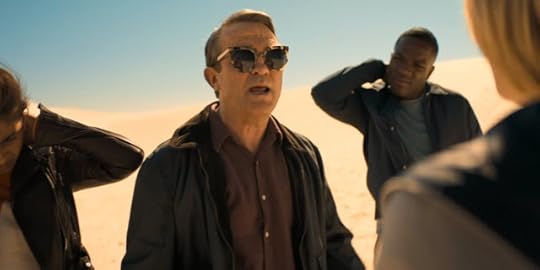 “Can people and things stop putting stuff inside me without my permission!”
“Can people and things stop putting stuff inside me without my permission!”Above all else though, “The Ghost Monument” is an episode designed to see its characters flourish, and for the most part that is exactly what they do. Bradley Walsh is the clear standout once again, continuing to astonish me with his dramatic acting chops in the same way that Billie Piper did more than thirteen years ago. His character’s chipper spirit in the face of the most chaotic adversity, particularly given the devastating loss that he’s just suffered, is exceptionally endearing. He has shades of former companions - sorry, former friends - as sundry as Ian Chesterton, Ace, Donna Noble and Wilfred Mott about him along with something bright and new. His step-grandson, Ryan, enjoys another strong outing too. “The Ghost Monument” teaches Tosin Cole’s character some invaluable lessons about life alongside the Doctor, and does so in ways that range from hilarious to heartrending. When the Doctor condemns the use of weaponry, only for him to ignore her counsel, you have to laugh as his Call of Duty skills backfire and send him guiltily scurrying back to her. Later, when the Doctor tells him that she’s “proper proud” of him in an attempt to get him to quickly climb a ladder despite his dyspraxia, you can’t help but share in that pride - and, if you’re anything like me, feel another atrium full of doubts about Jodie Whittaker’s Doctor pump straight out of your heart.
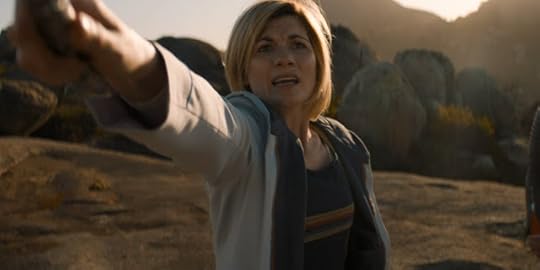 “Come to Daddy... I mean Mummy.”
“Come to Daddy... I mean Mummy.”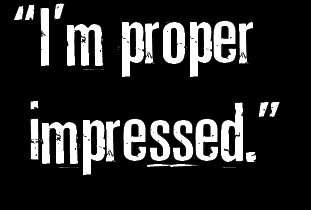 Whilst still a little too Tennanty for her own good at times, and - so far - too fifth-Doctory when it comes to gravitas, “The Ghost Monument” truly marks the arrival of Whittaker’s incarnation. This episode is as much hour two of a two-hour premiere as it is a stand-alone story, and this is most evident in the Doctor’s increasing poise. Here we see her start to discover who she really is, who she’s going to be, and - beguilingly - perhaps even who she once was in the very beginning. The last thing that I was expecting this season to do was revitalise the mystery of the Doctor, but, for viewers new and old, that’s what it’s doing - and doing tantalisingly. I’m proper impressed.
Whilst still a little too Tennanty for her own good at times, and - so far - too fifth-Doctory when it comes to gravitas, “The Ghost Monument” truly marks the arrival of Whittaker’s incarnation. This episode is as much hour two of a two-hour premiere as it is a stand-alone story, and this is most evident in the Doctor’s increasing poise. Here we see her start to discover who she really is, who she’s going to be, and - beguilingly - perhaps even who she once was in the very beginning. The last thing that I was expecting this season to do was revitalise the mystery of the Doctor, but, for viewers new and old, that’s what it’s doing - and doing tantalisingly. I’m proper impressed.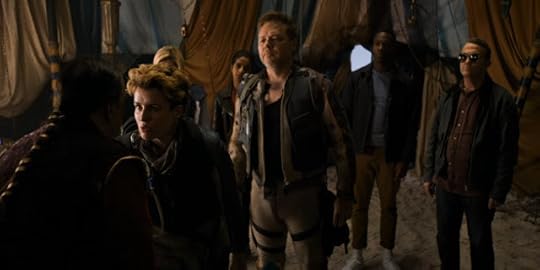 The episode’s guest stars were each as scorching as the wastes of Desolation. I wasn’t a fan of last week’s actor-focused trailer for the rest of the season; to me it veered too near to celebrating celebrities. But seeing supporting performers the calibre of these three in action shows that such fanfare was warranted. Shaun Dooley is just as brooding and intense as in just about everything else that I’ve ever seen him in, and Susan Lynch is even better – hard as Hell, but for a reason. Even Art Malik’s character’s non-presence somehow has real presence.
The episode’s guest stars were each as scorching as the wastes of Desolation. I wasn’t a fan of last week’s actor-focused trailer for the rest of the season; to me it veered too near to celebrating celebrities. But seeing supporting performers the calibre of these three in action shows that such fanfare was warranted. Shaun Dooley is just as brooding and intense as in just about everything else that I’ve ever seen him in, and Susan Lynch is even better – hard as Hell, but for a reason. Even Art Malik’s character’s non-presence somehow has real presence.If there is one problem with this episode, it’s Yas’s near-redundancy. Whilst she does enjoy a nice moment reflecting on her love for her family, and to my delight made a comment about Surrey Street’s locally infamous green police box (the nonsense of which used to drive me nuts as a kid!), her character has no real involvement in the plot. This is something that I think is going to be inevitable for at least one regular going forward, given that the writers have four of them to serve each week, but this needn’t harm the show provided that its scripts continue to “check in” once or twice with the short-straw companion as Chibnall’s does with Yas here. The binge-watching habits of millennials allow the show much more leeway on matters such as this than it had back in 1963 or even 1981 - the only two occasions (on telly) when we’ve had such a crowded TARDIS for a sustained period.
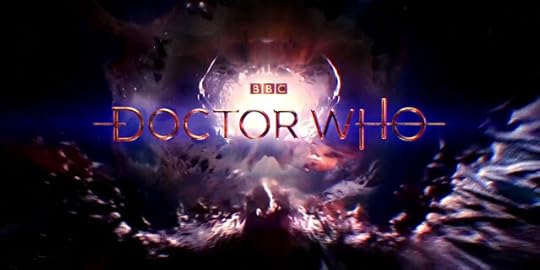 “The Ghost Monument” is also notable for establishing the title sequence and TARDIS for this new era. The former I loved - the haunting yet conventional take on the theme tune, the less intricate and more classic visuals - albeit with the caveat that I’m not a fan of opening an episode with it. I can see why they did so here - there was no teaser in the traditional sense; just a cliffhanger get-out - but in future I think this would be better placed after the customary cliffhanging teaser. The TARDIS, meanwhile, is the most inspiring that it’s looked since the series’ so-called “grunge phase” of 2005-2010. The exterior has finally shed that awful, Cushing-esque sheen, and the interior is something else altogether. I’m especially taken with the complete police box shell being incorporated into the design - it’s exactly how I always pictured that classic-series lacuna between the police box doors and seemingly separate console room entrance in my head.
“The Ghost Monument” is also notable for establishing the title sequence and TARDIS for this new era. The former I loved - the haunting yet conventional take on the theme tune, the less intricate and more classic visuals - albeit with the caveat that I’m not a fan of opening an episode with it. I can see why they did so here - there was no teaser in the traditional sense; just a cliffhanger get-out - but in future I think this would be better placed after the customary cliffhanging teaser. The TARDIS, meanwhile, is the most inspiring that it’s looked since the series’ so-called “grunge phase” of 2005-2010. The exterior has finally shed that awful, Cushing-esque sheen, and the interior is something else altogether. I’m especially taken with the complete police box shell being incorporated into the design - it’s exactly how I always pictured that classic-series lacuna between the police box doors and seemingly separate console room entrance in my head.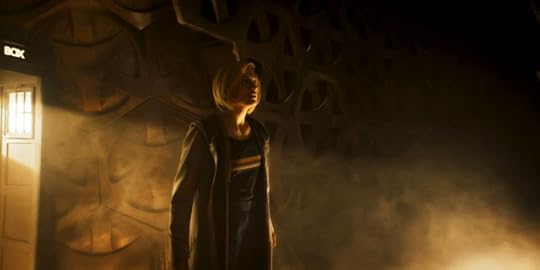
It’s been an marvellous and welcome surprise to find that something I feared would kill Doctor Who has helped to breathe life back into it. I’m still saddened that I can’t put myself into the Doctor’s shoes anymore, but when watching the programme as something new, as opposed to something weighed down by more than half a century’s convoluted continuity and preconceptions, I’m utterly enthralled by it. And so, tail between my legs (and yes, I’m fully aware of the acute irony of this phrase here), I’ve reinstated the old History of the Doctor website. The Doctor might be a woman now, but the realisation is slowly dawning on me that she’s still the same chap at hearts.
The new series of Doctor Who airs on Sunday nights on BBC One and is available to stream or download on BBC iPlayer in the UK, where the preceding 147 episodes are also currently available. A series pass is available from iTunes for £23.99.
Published on October 18, 2018 06:04
October 9, 2018
TV Review: Lucky for Some? Accepting Doctor Who: “The Woman Who Fell to Earth” by Chris Chibnall
After almost fifty-five actual years and a couple of thousand pretend ones, the Doctor has become the BBC’s first prime-time transgender hero.
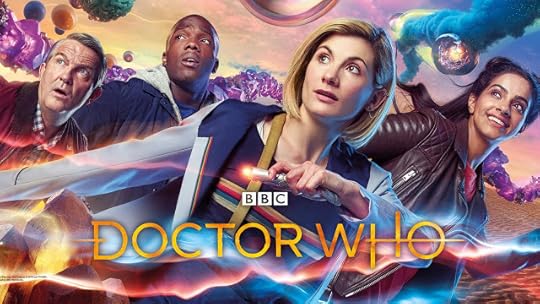
Last year I resolved not to watch Doctor Who anymore. Recent series had done little but madden me, taking an actor the calibre of Peter Capaldi - someone who had all the tools to be the definitive incarnation of the Doctor – and presenting him with one lacklustre script after another. Within a few short years, I had gone from obsessively curating a popular Doctor Who reviews website to going as long as twelve to eighteen months after transmission before begrudgingly sitting down to watch an episode. I was the first to admit that the show needed reinvention, but I have really struggled to come to terms with the sheer magnitude of that reinvention.
Whilst I never shared the toxic, dogmatic views of many who took to social media to condemn Jodie Whittaker’s casting, I found myself in complete agreement with the softly spoken views of former Doctor Peter Davison, who was one of the few public figures brave enough to give voice to his concerns despite the inevitable backlash. Like many fans of the series, I wasn’t particularly upset about the show’s long-standing mythology being subverted - the prospect of Susan rocking up with a great bushy beard and a bald head rather amused me, as did the idea of an appearance from the Doctor’s meathead mate, Romano. I’d just lost my life-long role model, and felt a bit sad about that. That’s about all there was to it.
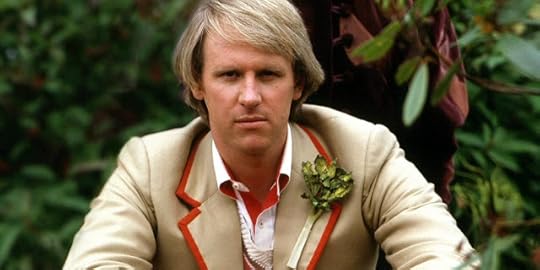 “If I feel any doubts, it’s the loss of a role model for boys who I think Doctor Who is vitally important for.”It’s a ludicrous thing to feel down about, really. The Doctor is supposed to be an alien who’s changed her entire body more than a dozen times over already. But to someone who - until mid-2011 or thereabouts, anyway – followed literally all of her adventures across the media, I’ve been feeling what I can only describe as grief. I know a lady whose little girl grew up to be her strapping son and all the guiltiness and anguish that she experienced as a result. That lady loves her son, but she still grieves for that lost little girl. It doesn’t make her sexist or narrow-minded; she’s just a human being dealing with a mind-bogglingly complicated and emotionally-charged situation. What I’ve been experiencing this last year isn’t anything close to that level of heartache, obviously, but it does come from the same bewildered sort of place – and it is a place of love.
“If I feel any doubts, it’s the loss of a role model for boys who I think Doctor Who is vitally important for.”It’s a ludicrous thing to feel down about, really. The Doctor is supposed to be an alien who’s changed her entire body more than a dozen times over already. But to someone who - until mid-2011 or thereabouts, anyway – followed literally all of her adventures across the media, I’ve been feeling what I can only describe as grief. I know a lady whose little girl grew up to be her strapping son and all the guiltiness and anguish that she experienced as a result. That lady loves her son, but she still grieves for that lost little girl. It doesn’t make her sexist or narrow-minded; she’s just a human being dealing with a mind-bogglingly complicated and emotionally-charged situation. What I’ve been experiencing this last year isn’t anything close to that level of heartache, obviously, but it does come from the same bewildered sort of place – and it is a place of love.
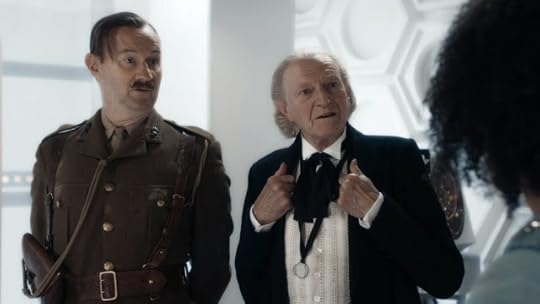 “Oh, my dear, I... I hope it doesn't offend you,that I have had some experience with the... fairer sex.”
“Oh, my dear, I... I hope it doesn't offend you,that I have had some experience with the... fairer sex.”
Every time I thought I’d come to terms with the new status quo, I’d take two steps back. I forced myself through Capaldi’s last season, half-swayed by his lecture about the ancient civilisation of Gallifrey not concerning itself with something as trivial is gender, only to be snapped back hard by the lecturing “Twice upon a Time” and its unwarranted, retrospective reimagining of the first Doctor as a rampant chauvinist. Every time I saw Missy, I’d be floored by what a truly fantastic character she is, only to watch her diverge so far from the Master that she found herself directly at odds with him. Over the course of three seasons the writers softened Missy, made her compassionate, even allied her with the Doctor. They took every hackneyed, empathetic female stereotype and used it to annihilate any last vestige of a once-great arch-villain. It made a mockery of all those who argued that a character’s gender is of no consequence. The Master’s change of gender altered her so clearly and so utterly that changing his name wasn’t enough: she had to kill himself. It had become an inescapable narrative imperative.
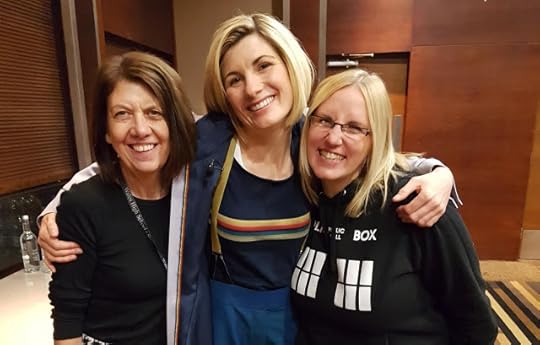 Above: Sue Cooper, Jodie Whittaker, V.E. Bolton.
Above: Sue Cooper, Jodie Whittaker, V.E. Bolton.
It was only very recently that I relented. My sister, who teaches in a Sheffield school, was fortunate enough to meet Jodie Whittaker when she came in to surprise her students with a sneak peek at her debut episode. Despite her own reservations about the Doctor’s change of sex (which I understand arose largely from how the Doctor’s relationships with some of his companions had been portrayed, Rose in particular), my sister was won over by Whittaker at least enough to give the new season a chance, thus piling the pressure on me to follow suit.
This last year I’ve also been keeping up with my Big Finish listening, and in their magnificent Gallifrey: Time War series there was a transgender regeneration that I thought was handled exceptionally well – by which I mean it wasn’t even acknowledged. It just happened and everyone moved on; even Ace wasn’t fazed by it. It was probably this that ultimately tipped the scales towards acceptance for me. This, and the knowledge that if I didn’t watch, I would indeed be guilty of prejudice – quite literally pre-judging something I’d never seen. After thoroughly entertaining me for thirty-odd years, Doctor Who deserved another chance, right?
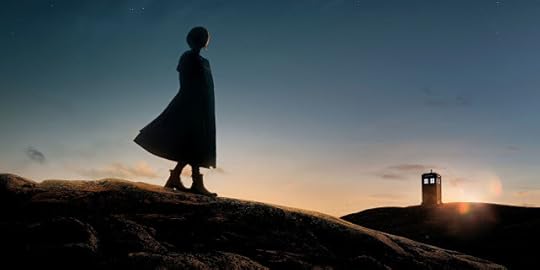 “I suppose one more lifetime wouldn’t kill anyone. Well, except me...”
“I suppose one more lifetime wouldn’t kill anyone. Well, except me...”
The first thing to strike me about “The Woman Who Fell to Earth” was its radically different look. The BBC logo appears centre-screen before cutting straight to the action, Marvel-style. For the first time ever, there was no title sequence to be found anywhere in the episode – not even after the Doctor’s dramatic entrance, at which point the pull of that familiar howl must have been near impossible for the producers to resist. There were no inlaid credits, either. Even Segun Akinola’s score was far sparser and more subdued than Murray Gold’s ever was, although when it did swell up, it did so triumphantly, with what I’m sure will become Thirteen’s theme instantly raising goosebumps. This new season is unashamedly television custom-made for the binge-watchers of tomorrow. A new look. A new sound. A new Sunday slot. A new era.
 “Is it wrong to be enjoying this?”
“Is it wrong to be enjoying this?”
Beautiful vistas from my home city were marred only by their failure to fill my screen. The series’ trendy 2:1 aspect ratio might cajole the odd critic into throwing the word “cinematic” into their tabloid review, but it’s as much because they associate black bars across the tops and bottoms of their screens with watching a movie as it is due to any cinematographic wonders captured by the production team’s new anamorphic lenses. All this format does for me is remind me of the dark old days of watching 14:9 BBC-cropped X-Files episodes on a 4:3 TV. I will never understand why it’s become chic to produce a programme specifically for viewing on a particular device in a frame too small for that very device. Whatever happened to broadcast standards? It’s just robbing viewers of pixels.
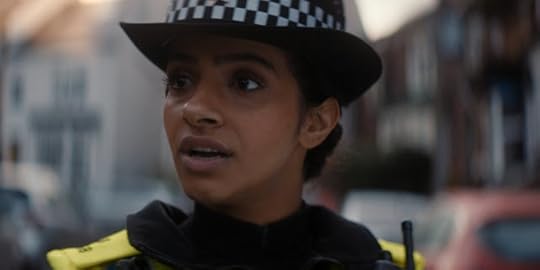 Very quickly, though, I found myself focusing less on the series’ annoying new letterbox format and more on the instantly appealing characters. Whilst my views on Chris Chibnall’s Doctor Who episodes to date have been mixed, he’s had more hits than misses for me. I was also a huge fan of Torchwood during his tenure as its showrunner, and Broadchurch is without a doubt one of the greatest British series to come out of this golden age of telly. At his best, Chibnall is able to create and quickly make you care about characters that are both very ordinary, yet somehow extraordinary, and I was delighted to see him hit the ground running. Mandip Gill’s young trainee police officer, Yaz, was a delight from the moment that she opened her mouth. There she was, stuck in a pedestrian job that she’d yet to really find her feet in, unsure how to even go about reporting an alien attack on a train to her superiors, and yet before the night was over she was competently helping the Doctor to defend an innocent crane driver against an alien hunter. It was like Zootropolis, only with tooth-faced monsters instead of drugged-up predators.
Very quickly, though, I found myself focusing less on the series’ annoying new letterbox format and more on the instantly appealing characters. Whilst my views on Chris Chibnall’s Doctor Who episodes to date have been mixed, he’s had more hits than misses for me. I was also a huge fan of Torchwood during his tenure as its showrunner, and Broadchurch is without a doubt one of the greatest British series to come out of this golden age of telly. At his best, Chibnall is able to create and quickly make you care about characters that are both very ordinary, yet somehow extraordinary, and I was delighted to see him hit the ground running. Mandip Gill’s young trainee police officer, Yaz, was a delight from the moment that she opened her mouth. There she was, stuck in a pedestrian job that she’d yet to really find her feet in, unsure how to even go about reporting an alien attack on a train to her superiors, and yet before the night was over she was competently helping the Doctor to defend an innocent crane driver against an alien hunter. It was like Zootropolis, only with tooth-faced monsters instead of drugged-up predators.
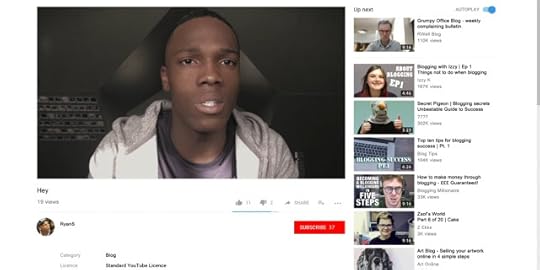 Tosin Cole’s Ryan is also a case in point – likeable, relatable, but living with a condition that very few viewers probably knew much about prior to watching the episode. His show-stealing, go-getting nan, Grace, vibrantly portrayed by Sharon D Clarke, was just as quick to endear herself to me, as was – to my astonishment – her husband Graham. I’ve never seen Bradley Walsh give so dazzling a performance before. In sixty-three minutes his retired bus driver took viewers through the whole gamut of human emotion, from humour to heartbreak through just about everything in between. He was awesome.
Tosin Cole’s Ryan is also a case in point – likeable, relatable, but living with a condition that very few viewers probably knew much about prior to watching the episode. His show-stealing, go-getting nan, Grace, vibrantly portrayed by Sharon D Clarke, was just as quick to endear herself to me, as was – to my astonishment – her husband Graham. I’ve never seen Bradley Walsh give so dazzling a performance before. In sixty-three minutes his retired bus driver took viewers through the whole gamut of human emotion, from humour to heartbreak through just about everything in between. He was awesome.
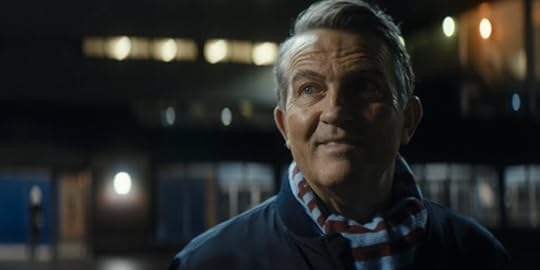 And an older human companion opens up so many fresh areas of storytelling for the show. Big Finish saw the sense in bringing in an older companion for the Doctor long ago, and it’s great to see their influence over the series continuing into this brave new era. Many of my favourite moments in the episode were scenes between Grace and Graham – they seemed to hit just the right note between mundane and heightened; that elusive and magical Doctor Who blend that Russell T Davies first perfected thirteen years ago. With Graham rounding out the TARDIS crew we might just have the makings of a team to rival the original 1963 contingent on our hands here.
And an older human companion opens up so many fresh areas of storytelling for the show. Big Finish saw the sense in bringing in an older companion for the Doctor long ago, and it’s great to see their influence over the series continuing into this brave new era. Many of my favourite moments in the episode were scenes between Grace and Graham – they seemed to hit just the right note between mundane and heightened; that elusive and magical Doctor Who blend that Russell T Davies first perfected thirteen years ago. With Graham rounding out the TARDIS crew we might just have the makings of a team to rival the original 1963 contingent on our hands here.
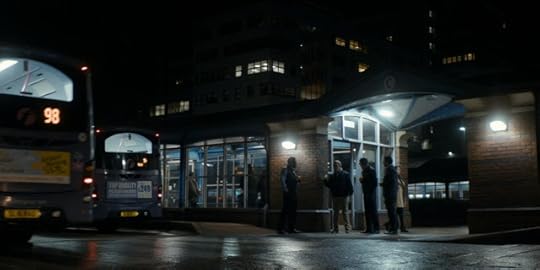 Perhaps the thing that I enjoyed most about the episode though was its setting. Given all the time that I spent in Sheffield as a young man, it was fantastic to see bus shelters that I’ve stood in and roads that I’ve driven down immortalised in an episode of Doctor Who. Within the fiction too, the episode’s setting felt fresh and original, lending the series a sense of sincerity that I think it often loses when it spends too much time in or around London and other done-to-death filming locations. And just like the new regular characters, every one of Chibnall’s supporting players shone. From the self-help-seeking crane driver to the guy picking his salad out of his kebab, they were all so very redolent of people that I grew up around, yet there they were, being menaced by aliens but still drunkenly lobbing tomatoes at them (“’alowe’en’s next monf mate...”). Even the Doctor’s incredibly Yorkshire “Tim Shaw” gag cracked me up. It’s hard to point to another show that can have a monster of the week that’s as hilarious as “Tim Shaw” is without having things descend into utter farce.
Perhaps the thing that I enjoyed most about the episode though was its setting. Given all the time that I spent in Sheffield as a young man, it was fantastic to see bus shelters that I’ve stood in and roads that I’ve driven down immortalised in an episode of Doctor Who. Within the fiction too, the episode’s setting felt fresh and original, lending the series a sense of sincerity that I think it often loses when it spends too much time in or around London and other done-to-death filming locations. And just like the new regular characters, every one of Chibnall’s supporting players shone. From the self-help-seeking crane driver to the guy picking his salad out of his kebab, they were all so very redolent of people that I grew up around, yet there they were, being menaced by aliens but still drunkenly lobbing tomatoes at them (“’alowe’en’s next monf mate...”). Even the Doctor’s incredibly Yorkshire “Tim Shaw” gag cracked me up. It’s hard to point to another show that can have a monster of the week that’s as hilarious as “Tim Shaw” is without having things descend into utter farce.
As to the plot, one of my biggest issues with Doctor Who since “The Day of the Doctor” has been its eschewing of consequences. Particularly during Peter Capaldi’s tenure, which was characterised by its bold part ones and cop-out part twos, it was hard for me to care about whatever I was seeing on screen because I realised that Steven Moffat would just undo it if it risked really mattering. Chris Chibnall, on the other hand, imbued Torchwood with a genuinely dangerous “anything-can-happen” vibe, and probably the most outstanding thing about his Broadchurch was its refusal to limit itself to the standard murder-mystery format. Once Hardy and Miller had caught their child-killer, Chibnall’s story was only really gathering pace – the larger drama of the trial and the long-term aftermath was still to come. If the closing act of “The Woman Who Fell to Earth” is anything to go by, Chibnall will stay true to his strengths as a writer and explore the human cost of the Doctor’s meddling, and that is most definitely something that I’m excited to see more of.
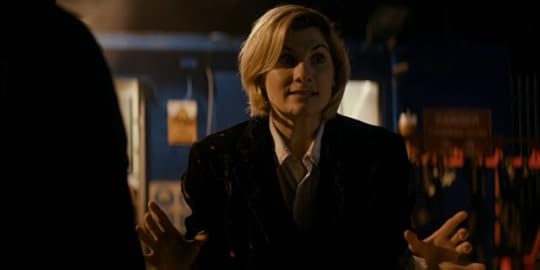
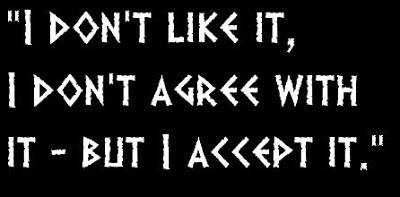 Turning to the Doctor herself, it’s a credit to both Chibnall and Whittaker that the Doctor’s gender was never a factor in the story at all. It was acknowledged a few times, but only in little asides that were often buried in her post-regenerative ramblings. In the long-term this bodes very well for the future of the series, but the rub comes in the Doctor’s characterisation, which was, even for a post-regeneration story, rather thin on the ground. Whittaker spent most of the episode channelling David Tennant’s regular patter, only seeming to add her own catchphrasey little flourishes (“Should be fine...”) to her Tennant template in the episode’s final furlong. Measure this against “The Eleventh Hour”, which Matt Smith owned from the moment he stepped out of the TARDIS doors, and note the difference. Even Peter Capaldi was his distinctive, gruff old self right from the moment he opened up those big scary eyes. Each incarnation of the Doctor should be the same, yet different. This Doctor, astonishingly, is more of the same.
Turning to the Doctor herself, it’s a credit to both Chibnall and Whittaker that the Doctor’s gender was never a factor in the story at all. It was acknowledged a few times, but only in little asides that were often buried in her post-regenerative ramblings. In the long-term this bodes very well for the future of the series, but the rub comes in the Doctor’s characterisation, which was, even for a post-regeneration story, rather thin on the ground. Whittaker spent most of the episode channelling David Tennant’s regular patter, only seeming to add her own catchphrasey little flourishes (“Should be fine...”) to her Tennant template in the episode’s final furlong. Measure this against “The Eleventh Hour”, which Matt Smith owned from the moment he stepped out of the TARDIS doors, and note the difference. Even Peter Capaldi was his distinctive, gruff old self right from the moment he opened up those big scary eyes. Each incarnation of the Doctor should be the same, yet different. This Doctor, astonishingly, is more of the same.
I strongly suspect that the familiarity of Whittaker’s post-regenerative performance was a conscious move on the production team’s part intended to appease long-term viewers who might be struggling with the Doctor’s newfound womanhood, and that as the season rolls on Whittaker will claim this incarnation of the Doctor as her own. We all know that she certainly has the talent to put her own distinctive stamp on it. And there are certainly plenty of positives to be found in her dynamic portrayal in this season-opener – her voice, her humour, her physicality – but so far we have seen none of that weight, none of that fire, that every modern Doctor has had burning behind his cold eyes right from the start. She needs to find that fast as the whole series is going to live or die on the strength of the next couple of episodes. The largest audience since the glory days of RTD tuned in on Sunday evening to see what all the fuss was about, but can she hold them there?
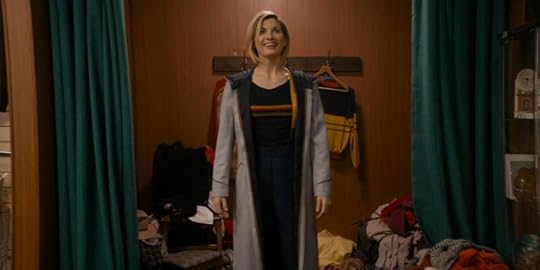
A final disappointment with the episode was, of all things, its end title sequence. As the opening title sequence had been omitted (or dispensed with for good?), I was expecting it to close the episode in the same sort of way that Spock’s speech and Alexander Courage’s original Star Trek theme had closed the 2009 Star Trek movie. Once the Doctor had her new outfit and her new mission, a proper title sequence felt “earned”, and would have made for quite the uplifting finale. Instead, ending on really quite a bleak cliffhanger followed by just the standard scrolling text felt a little flat. Had it not been for me wanting to listen to Akinola’s new haunting rendition of the classic theme, I’d have probably switched off immediately.
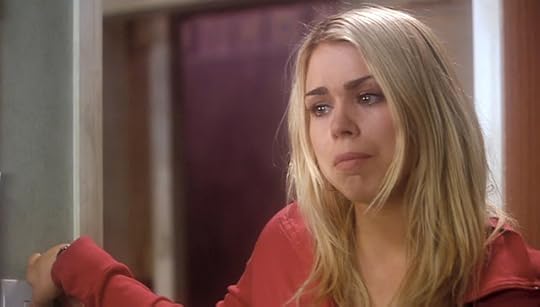 “I thought I knew him, Mum...
“I thought I knew him, Mum...
then he goes and does this...”
This is the age of press-fuelled populism - what the papers want, the papers get. As everyone’s favourite robot-romancing, Sabacc-playing, cape-swishing smoothie would put it, “I don’t like it, I don’t agree with it - but I accept it.” The Doctor’s a woman now, whether I like it or not; more category than character. Yet as a result of this ballsy move, the series has recaptured the zeitgeist that has eluded it for many years. I might still be feeling like Rose in “The Christmas Invasion”, desperately trying to process a change that’s a little beyond both my brain and my heart, but perhaps that’s a small price to pay if legions of little girls worldwide are having their eyes opened to science fiction. I just hope my two will join their ranks when we tune in next week. And tune in we shall.
The new series of Doctor Who airs on Sunday nights on BBC One and is available to stream or download on BBC iPlayer in the UK, where the preceding 146 episodes are also currently available. A series pass is available from iTunes for £23.99.

Last year I resolved not to watch Doctor Who anymore. Recent series had done little but madden me, taking an actor the calibre of Peter Capaldi - someone who had all the tools to be the definitive incarnation of the Doctor – and presenting him with one lacklustre script after another. Within a few short years, I had gone from obsessively curating a popular Doctor Who reviews website to going as long as twelve to eighteen months after transmission before begrudgingly sitting down to watch an episode. I was the first to admit that the show needed reinvention, but I have really struggled to come to terms with the sheer magnitude of that reinvention.
Whilst I never shared the toxic, dogmatic views of many who took to social media to condemn Jodie Whittaker’s casting, I found myself in complete agreement with the softly spoken views of former Doctor Peter Davison, who was one of the few public figures brave enough to give voice to his concerns despite the inevitable backlash. Like many fans of the series, I wasn’t particularly upset about the show’s long-standing mythology being subverted - the prospect of Susan rocking up with a great bushy beard and a bald head rather amused me, as did the idea of an appearance from the Doctor’s meathead mate, Romano. I’d just lost my life-long role model, and felt a bit sad about that. That’s about all there was to it.
 “If I feel any doubts, it’s the loss of a role model for boys who I think Doctor Who is vitally important for.”It’s a ludicrous thing to feel down about, really. The Doctor is supposed to be an alien who’s changed her entire body more than a dozen times over already. But to someone who - until mid-2011 or thereabouts, anyway – followed literally all of her adventures across the media, I’ve been feeling what I can only describe as grief. I know a lady whose little girl grew up to be her strapping son and all the guiltiness and anguish that she experienced as a result. That lady loves her son, but she still grieves for that lost little girl. It doesn’t make her sexist or narrow-minded; she’s just a human being dealing with a mind-bogglingly complicated and emotionally-charged situation. What I’ve been experiencing this last year isn’t anything close to that level of heartache, obviously, but it does come from the same bewildered sort of place – and it is a place of love.
“If I feel any doubts, it’s the loss of a role model for boys who I think Doctor Who is vitally important for.”It’s a ludicrous thing to feel down about, really. The Doctor is supposed to be an alien who’s changed her entire body more than a dozen times over already. But to someone who - until mid-2011 or thereabouts, anyway – followed literally all of her adventures across the media, I’ve been feeling what I can only describe as grief. I know a lady whose little girl grew up to be her strapping son and all the guiltiness and anguish that she experienced as a result. That lady loves her son, but she still grieves for that lost little girl. It doesn’t make her sexist or narrow-minded; she’s just a human being dealing with a mind-bogglingly complicated and emotionally-charged situation. What I’ve been experiencing this last year isn’t anything close to that level of heartache, obviously, but it does come from the same bewildered sort of place – and it is a place of love. “Oh, my dear, I... I hope it doesn't offend you,that I have had some experience with the... fairer sex.”
“Oh, my dear, I... I hope it doesn't offend you,that I have had some experience with the... fairer sex.”Every time I thought I’d come to terms with the new status quo, I’d take two steps back. I forced myself through Capaldi’s last season, half-swayed by his lecture about the ancient civilisation of Gallifrey not concerning itself with something as trivial is gender, only to be snapped back hard by the lecturing “Twice upon a Time” and its unwarranted, retrospective reimagining of the first Doctor as a rampant chauvinist. Every time I saw Missy, I’d be floored by what a truly fantastic character she is, only to watch her diverge so far from the Master that she found herself directly at odds with him. Over the course of three seasons the writers softened Missy, made her compassionate, even allied her with the Doctor. They took every hackneyed, empathetic female stereotype and used it to annihilate any last vestige of a once-great arch-villain. It made a mockery of all those who argued that a character’s gender is of no consequence. The Master’s change of gender altered her so clearly and so utterly that changing his name wasn’t enough: she had to kill himself. It had become an inescapable narrative imperative.
 Above: Sue Cooper, Jodie Whittaker, V.E. Bolton.
Above: Sue Cooper, Jodie Whittaker, V.E. Bolton.It was only very recently that I relented. My sister, who teaches in a Sheffield school, was fortunate enough to meet Jodie Whittaker when she came in to surprise her students with a sneak peek at her debut episode. Despite her own reservations about the Doctor’s change of sex (which I understand arose largely from how the Doctor’s relationships with some of his companions had been portrayed, Rose in particular), my sister was won over by Whittaker at least enough to give the new season a chance, thus piling the pressure on me to follow suit.
This last year I’ve also been keeping up with my Big Finish listening, and in their magnificent Gallifrey: Time War series there was a transgender regeneration that I thought was handled exceptionally well – by which I mean it wasn’t even acknowledged. It just happened and everyone moved on; even Ace wasn’t fazed by it. It was probably this that ultimately tipped the scales towards acceptance for me. This, and the knowledge that if I didn’t watch, I would indeed be guilty of prejudice – quite literally pre-judging something I’d never seen. After thoroughly entertaining me for thirty-odd years, Doctor Who deserved another chance, right?
 “I suppose one more lifetime wouldn’t kill anyone. Well, except me...”
“I suppose one more lifetime wouldn’t kill anyone. Well, except me...”The first thing to strike me about “The Woman Who Fell to Earth” was its radically different look. The BBC logo appears centre-screen before cutting straight to the action, Marvel-style. For the first time ever, there was no title sequence to be found anywhere in the episode – not even after the Doctor’s dramatic entrance, at which point the pull of that familiar howl must have been near impossible for the producers to resist. There were no inlaid credits, either. Even Segun Akinola’s score was far sparser and more subdued than Murray Gold’s ever was, although when it did swell up, it did so triumphantly, with what I’m sure will become Thirteen’s theme instantly raising goosebumps. This new season is unashamedly television custom-made for the binge-watchers of tomorrow. A new look. A new sound. A new Sunday slot. A new era.
 “Is it wrong to be enjoying this?”
“Is it wrong to be enjoying this?”Beautiful vistas from my home city were marred only by their failure to fill my screen. The series’ trendy 2:1 aspect ratio might cajole the odd critic into throwing the word “cinematic” into their tabloid review, but it’s as much because they associate black bars across the tops and bottoms of their screens with watching a movie as it is due to any cinematographic wonders captured by the production team’s new anamorphic lenses. All this format does for me is remind me of the dark old days of watching 14:9 BBC-cropped X-Files episodes on a 4:3 TV. I will never understand why it’s become chic to produce a programme specifically for viewing on a particular device in a frame too small for that very device. Whatever happened to broadcast standards? It’s just robbing viewers of pixels.
 Very quickly, though, I found myself focusing less on the series’ annoying new letterbox format and more on the instantly appealing characters. Whilst my views on Chris Chibnall’s Doctor Who episodes to date have been mixed, he’s had more hits than misses for me. I was also a huge fan of Torchwood during his tenure as its showrunner, and Broadchurch is without a doubt one of the greatest British series to come out of this golden age of telly. At his best, Chibnall is able to create and quickly make you care about characters that are both very ordinary, yet somehow extraordinary, and I was delighted to see him hit the ground running. Mandip Gill’s young trainee police officer, Yaz, was a delight from the moment that she opened her mouth. There she was, stuck in a pedestrian job that she’d yet to really find her feet in, unsure how to even go about reporting an alien attack on a train to her superiors, and yet before the night was over she was competently helping the Doctor to defend an innocent crane driver against an alien hunter. It was like Zootropolis, only with tooth-faced monsters instead of drugged-up predators.
Very quickly, though, I found myself focusing less on the series’ annoying new letterbox format and more on the instantly appealing characters. Whilst my views on Chris Chibnall’s Doctor Who episodes to date have been mixed, he’s had more hits than misses for me. I was also a huge fan of Torchwood during his tenure as its showrunner, and Broadchurch is without a doubt one of the greatest British series to come out of this golden age of telly. At his best, Chibnall is able to create and quickly make you care about characters that are both very ordinary, yet somehow extraordinary, and I was delighted to see him hit the ground running. Mandip Gill’s young trainee police officer, Yaz, was a delight from the moment that she opened her mouth. There she was, stuck in a pedestrian job that she’d yet to really find her feet in, unsure how to even go about reporting an alien attack on a train to her superiors, and yet before the night was over she was competently helping the Doctor to defend an innocent crane driver against an alien hunter. It was like Zootropolis, only with tooth-faced monsters instead of drugged-up predators. Tosin Cole’s Ryan is also a case in point – likeable, relatable, but living with a condition that very few viewers probably knew much about prior to watching the episode. His show-stealing, go-getting nan, Grace, vibrantly portrayed by Sharon D Clarke, was just as quick to endear herself to me, as was – to my astonishment – her husband Graham. I’ve never seen Bradley Walsh give so dazzling a performance before. In sixty-three minutes his retired bus driver took viewers through the whole gamut of human emotion, from humour to heartbreak through just about everything in between. He was awesome.
Tosin Cole’s Ryan is also a case in point – likeable, relatable, but living with a condition that very few viewers probably knew much about prior to watching the episode. His show-stealing, go-getting nan, Grace, vibrantly portrayed by Sharon D Clarke, was just as quick to endear herself to me, as was – to my astonishment – her husband Graham. I’ve never seen Bradley Walsh give so dazzling a performance before. In sixty-three minutes his retired bus driver took viewers through the whole gamut of human emotion, from humour to heartbreak through just about everything in between. He was awesome. And an older human companion opens up so many fresh areas of storytelling for the show. Big Finish saw the sense in bringing in an older companion for the Doctor long ago, and it’s great to see their influence over the series continuing into this brave new era. Many of my favourite moments in the episode were scenes between Grace and Graham – they seemed to hit just the right note between mundane and heightened; that elusive and magical Doctor Who blend that Russell T Davies first perfected thirteen years ago. With Graham rounding out the TARDIS crew we might just have the makings of a team to rival the original 1963 contingent on our hands here.
And an older human companion opens up so many fresh areas of storytelling for the show. Big Finish saw the sense in bringing in an older companion for the Doctor long ago, and it’s great to see their influence over the series continuing into this brave new era. Many of my favourite moments in the episode were scenes between Grace and Graham – they seemed to hit just the right note between mundane and heightened; that elusive and magical Doctor Who blend that Russell T Davies first perfected thirteen years ago. With Graham rounding out the TARDIS crew we might just have the makings of a team to rival the original 1963 contingent on our hands here. Perhaps the thing that I enjoyed most about the episode though was its setting. Given all the time that I spent in Sheffield as a young man, it was fantastic to see bus shelters that I’ve stood in and roads that I’ve driven down immortalised in an episode of Doctor Who. Within the fiction too, the episode’s setting felt fresh and original, lending the series a sense of sincerity that I think it often loses when it spends too much time in or around London and other done-to-death filming locations. And just like the new regular characters, every one of Chibnall’s supporting players shone. From the self-help-seeking crane driver to the guy picking his salad out of his kebab, they were all so very redolent of people that I grew up around, yet there they were, being menaced by aliens but still drunkenly lobbing tomatoes at them (“’alowe’en’s next monf mate...”). Even the Doctor’s incredibly Yorkshire “Tim Shaw” gag cracked me up. It’s hard to point to another show that can have a monster of the week that’s as hilarious as “Tim Shaw” is without having things descend into utter farce.
Perhaps the thing that I enjoyed most about the episode though was its setting. Given all the time that I spent in Sheffield as a young man, it was fantastic to see bus shelters that I’ve stood in and roads that I’ve driven down immortalised in an episode of Doctor Who. Within the fiction too, the episode’s setting felt fresh and original, lending the series a sense of sincerity that I think it often loses when it spends too much time in or around London and other done-to-death filming locations. And just like the new regular characters, every one of Chibnall’s supporting players shone. From the self-help-seeking crane driver to the guy picking his salad out of his kebab, they were all so very redolent of people that I grew up around, yet there they were, being menaced by aliens but still drunkenly lobbing tomatoes at them (“’alowe’en’s next monf mate...”). Even the Doctor’s incredibly Yorkshire “Tim Shaw” gag cracked me up. It’s hard to point to another show that can have a monster of the week that’s as hilarious as “Tim Shaw” is without having things descend into utter farce.As to the plot, one of my biggest issues with Doctor Who since “The Day of the Doctor” has been its eschewing of consequences. Particularly during Peter Capaldi’s tenure, which was characterised by its bold part ones and cop-out part twos, it was hard for me to care about whatever I was seeing on screen because I realised that Steven Moffat would just undo it if it risked really mattering. Chris Chibnall, on the other hand, imbued Torchwood with a genuinely dangerous “anything-can-happen” vibe, and probably the most outstanding thing about his Broadchurch was its refusal to limit itself to the standard murder-mystery format. Once Hardy and Miller had caught their child-killer, Chibnall’s story was only really gathering pace – the larger drama of the trial and the long-term aftermath was still to come. If the closing act of “The Woman Who Fell to Earth” is anything to go by, Chibnall will stay true to his strengths as a writer and explore the human cost of the Doctor’s meddling, and that is most definitely something that I’m excited to see more of.

 Turning to the Doctor herself, it’s a credit to both Chibnall and Whittaker that the Doctor’s gender was never a factor in the story at all. It was acknowledged a few times, but only in little asides that were often buried in her post-regenerative ramblings. In the long-term this bodes very well for the future of the series, but the rub comes in the Doctor’s characterisation, which was, even for a post-regeneration story, rather thin on the ground. Whittaker spent most of the episode channelling David Tennant’s regular patter, only seeming to add her own catchphrasey little flourishes (“Should be fine...”) to her Tennant template in the episode’s final furlong. Measure this against “The Eleventh Hour”, which Matt Smith owned from the moment he stepped out of the TARDIS doors, and note the difference. Even Peter Capaldi was his distinctive, gruff old self right from the moment he opened up those big scary eyes. Each incarnation of the Doctor should be the same, yet different. This Doctor, astonishingly, is more of the same.
Turning to the Doctor herself, it’s a credit to both Chibnall and Whittaker that the Doctor’s gender was never a factor in the story at all. It was acknowledged a few times, but only in little asides that were often buried in her post-regenerative ramblings. In the long-term this bodes very well for the future of the series, but the rub comes in the Doctor’s characterisation, which was, even for a post-regeneration story, rather thin on the ground. Whittaker spent most of the episode channelling David Tennant’s regular patter, only seeming to add her own catchphrasey little flourishes (“Should be fine...”) to her Tennant template in the episode’s final furlong. Measure this against “The Eleventh Hour”, which Matt Smith owned from the moment he stepped out of the TARDIS doors, and note the difference. Even Peter Capaldi was his distinctive, gruff old self right from the moment he opened up those big scary eyes. Each incarnation of the Doctor should be the same, yet different. This Doctor, astonishingly, is more of the same.I strongly suspect that the familiarity of Whittaker’s post-regenerative performance was a conscious move on the production team’s part intended to appease long-term viewers who might be struggling with the Doctor’s newfound womanhood, and that as the season rolls on Whittaker will claim this incarnation of the Doctor as her own. We all know that she certainly has the talent to put her own distinctive stamp on it. And there are certainly plenty of positives to be found in her dynamic portrayal in this season-opener – her voice, her humour, her physicality – but so far we have seen none of that weight, none of that fire, that every modern Doctor has had burning behind his cold eyes right from the start. She needs to find that fast as the whole series is going to live or die on the strength of the next couple of episodes. The largest audience since the glory days of RTD tuned in on Sunday evening to see what all the fuss was about, but can she hold them there?

A final disappointment with the episode was, of all things, its end title sequence. As the opening title sequence had been omitted (or dispensed with for good?), I was expecting it to close the episode in the same sort of way that Spock’s speech and Alexander Courage’s original Star Trek theme had closed the 2009 Star Trek movie. Once the Doctor had her new outfit and her new mission, a proper title sequence felt “earned”, and would have made for quite the uplifting finale. Instead, ending on really quite a bleak cliffhanger followed by just the standard scrolling text felt a little flat. Had it not been for me wanting to listen to Akinola’s new haunting rendition of the classic theme, I’d have probably switched off immediately.
 “I thought I knew him, Mum...
“I thought I knew him, Mum...then he goes and does this...”
This is the age of press-fuelled populism - what the papers want, the papers get. As everyone’s favourite robot-romancing, Sabacc-playing, cape-swishing smoothie would put it, “I don’t like it, I don’t agree with it - but I accept it.” The Doctor’s a woman now, whether I like it or not; more category than character. Yet as a result of this ballsy move, the series has recaptured the zeitgeist that has eluded it for many years. I might still be feeling like Rose in “The Christmas Invasion”, desperately trying to process a change that’s a little beyond both my brain and my heart, but perhaps that’s a small price to pay if legions of little girls worldwide are having their eyes opened to science fiction. I just hope my two will join their ranks when we tune in next week. And tune in we shall.
The new series of Doctor Who airs on Sunday nights on BBC One and is available to stream or download on BBC iPlayer in the UK, where the preceding 146 episodes are also currently available. A series pass is available from iTunes for £23.99.
Published on October 09, 2018 12:08
Lucky for Some?
After almost fifty-five actual years and a couple of thousand pretend ones, the Doctor has become the BBC’s first prime-time transgender hero.

Last year I resolved not to watch Doctor Who anymore. Recent series had done little but madden me, taking an actor the calibre of Peter Capaldi - someone who had all the tools to be the definitive incarnation of the Doctor – and presenting him with one lacklustre script after another. Within a few short years, I had gone from obsessively curating a popular Doctor Who reviews website to going as long as twelve to eighteen months after transmission before begrudgingly sitting down to watch an episode. I was the first to admit that the show needed reinvention, but I have really struggled to come to terms with the sheer magnitude of that reinvention.
Whilst I never shared the toxic, dogmatic views of many who took to social media to condemn Jodie Whittaker’s casting, I found myself in complete agreement with the softly spoken views of former Doctor Peter Davison, who was one of the few public figures brave enough to give voice to his concerns despite the inevitable backlash. Like many fans of the series, I wasn’t particularly upset about the show’s long-standing mythology being twisted - the prospect of Susan rocking up with a great bushy beard and a bald head rather amused me, as did the idea of an appearance from the Doctor’s meathead mate, Romano - I’d just lost my life-long role model, and felt a bit sad about that. That’s about all there was to it.
 “If I feel any doubts, it’s the loss of a role model for boyswho I think Doctor Who is vitally important for.”It’s a ludicrous thing to feel down about, really. The Doctor is supposed to be an alien who’s changed her entire body more than a dozen times over already. But to someone who - until mid-2011 or thereabouts, anyway – followed literally all of her adventures, over a thousand of them, I’ve been feeling what I can only describe as grief. I know a lady whose little girl grew up to be her strapping son and all the guiltiness and anguish that it involved for her. That lady loves her son, but she still grieves for that little girl she feels she lost. It doesn’t make her sexist or narrow-minded; she’s just a human being dealing with a mind-boggling complicated and highly emotional situation. What I’ve been experiencing this last year isn’t even anything close to that, obviously, but it does come from the same bewildered sort of place – and it is a place of love.
“If I feel any doubts, it’s the loss of a role model for boyswho I think Doctor Who is vitally important for.”It’s a ludicrous thing to feel down about, really. The Doctor is supposed to be an alien who’s changed her entire body more than a dozen times over already. But to someone who - until mid-2011 or thereabouts, anyway – followed literally all of her adventures, over a thousand of them, I’ve been feeling what I can only describe as grief. I know a lady whose little girl grew up to be her strapping son and all the guiltiness and anguish that it involved for her. That lady loves her son, but she still grieves for that little girl she feels she lost. It doesn’t make her sexist or narrow-minded; she’s just a human being dealing with a mind-boggling complicated and highly emotional situation. What I’ve been experiencing this last year isn’t even anything close to that, obviously, but it does come from the same bewildered sort of place – and it is a place of love.
 “Oh, my dear, I - I hope it doesn't offend you, that I have had some experience with the... fairer sex.”
“Oh, my dear, I - I hope it doesn't offend you, that I have had some experience with the... fairer sex.”
Every time I thought I’d come to terms with the new status quo, I’d take two steps back. I forced myself through Capaldi’s last season, half-swayed by his lecture about the ancient civilisation of Gallifrey not concerning itself with something as trivial is gender, only to be snapped back hard by the lecturing “Twice upon a Time” and its unwarranted, retrospective reimagining of the first Doctor as a rampant chauvinist. Every time I saw Missy, I’d be floored by what a truly fantastic character she is, only to watch her diverge so far from the Master that she found herself at odds with him. Over the course of three seasons the writers softened her, made her compassionate, even allied her with the Doctor. They took every hackneyed, empathetic female stereotype and used it to annihilate any last vestige of a once-great arch-villain. It made a mockery of all those who argued that a character’s gender is of no consequence. The Master’s change of gender changed her so clearly and so utterly that changing his name wasn’t enough: he had to kill herself. It had become an inescapable narrative imperative.
 Above: No idea, Jodie Whittaker, V.E. Bolton.
Above: No idea, Jodie Whittaker, V.E. Bolton.
It was only very recently that I relented. My sister, who teaches in a Sheffield school, was fortunate enough to meet Jodie Whittaker when she came in to surprise her students with a sneak peek at her debut episode. Despite her own reservations about the Doctor’s change of sex, my sister was won over by Whittaker at least enough to give the new season a chance, thus piling the pressure on me to follow suit.
This last year I’ve also been keeping up my Big Finish listening, and in their magnificent Gallifrey: Time War series there was a transgender regeneration that I thought was handled exceptionally well – by which I mean it wasn’t not even acknowledged. It just happened and everyone moved on; even Ace wasn’t fazed by it. It was probably this that ultimately tipped the scales for me. This, and the knowledge that if I didn’t watch, I would indeed be guilty of prejudice – quite literally pre-judging something I’d never seen. After thoroughly entertaining me for thirty-odd years, Doctor Who deserved another chance, right?
 “I suppose one more lifetime wouldn’t kill anyone. Well, except me...”
“I suppose one more lifetime wouldn’t kill anyone. Well, except me...”
The first thing to strike me about “The Woman Who Fell to Earth” was its radically different look. The BBC logo appears centre-screen before cutting straight to the action, Marvel-style. For the first time ever, there’s no title sequence anywhere in the episode – not even after the Doctor’s dramatic entrance. There are no inlaid credits. Even Segun Akinola’s score is far sparser and subdued than Murray Gold’s ever was. It’s television custom-made for the binge-watchers of tomorrow. A new look. A new sound. A new era.
 “Is it wrong to be enjoying this?”
“Is it wrong to be enjoying this?”
Beautiful vistas from my home city were marred only by their failure to fill my screen. The series’ trendy 2:1 aspect ratio might cajole the odd critic into throwing the word “cinematic” into their tabloid review, but it’s as much because they associate black bars across the tops and bottoms of their screens with watching a movie as it is due to any cinematographic wonders captured by the production team’s new anamorphic lenses. All this format does for me is remind me of the dark old days of watching 14:9 BBC-cropped X-Files episodes on a 4:3 TV. I will never understand why it’s suddenly become chic to produce a programme specifically for viewing on a particular device in a frame too small for that very device. Whatever happened to broadcast standards? It’s just robbing viewers of pixels.
 Very quickly, though, I found myself focusing less on the series’ annoying letterbox format and more on the instantly appealing characters. Whilst my views on Chris Chibnall’s Doctor Who episodes to date have been mixed, I loved Torchwood during his tenure as showrunner, and Broadchurch is without doubt one of the greatest British series to come out of this golden age of telly. At his best, Chibnall is able to create and quickly make you care about characters that are both very ordinary, yet somehow extraordinary, and I was delighted to see that from his very first scene he’d hit the ground running. Mandip Gill’s young trainee police officer, Yas, was a delight from the moment she opened her mouth. There she was, stuck in a pedestrian job that she’d yet to really find her feet in, unsure how to even go about reporting an alien attack on a train to her superiors, and yet before the night was over she was competently helping the Doctor to defend an innocent crane driver against an alien hunter – it’s like Zootropolis, only with tooth-faced monsters instead of drugged-up predators.
Very quickly, though, I found myself focusing less on the series’ annoying letterbox format and more on the instantly appealing characters. Whilst my views on Chris Chibnall’s Doctor Who episodes to date have been mixed, I loved Torchwood during his tenure as showrunner, and Broadchurch is without doubt one of the greatest British series to come out of this golden age of telly. At his best, Chibnall is able to create and quickly make you care about characters that are both very ordinary, yet somehow extraordinary, and I was delighted to see that from his very first scene he’d hit the ground running. Mandip Gill’s young trainee police officer, Yas, was a delight from the moment she opened her mouth. There she was, stuck in a pedestrian job that she’d yet to really find her feet in, unsure how to even go about reporting an alien attack on a train to her superiors, and yet before the night was over she was competently helping the Doctor to defend an innocent crane driver against an alien hunter – it’s like Zootropolis, only with tooth-faced monsters instead of drugged-up predators.
 Tosin Cole’s Ryan is also a case in point – likeable, relatable, but living with a condition that very few viewers probably knew much about prior to watching the episode. His show-stealing, go-getting nan, Grace, vibrantly portrayed by Sharon D Clarke, was just as quick to endear herself to me, as was – to my astonishment – her husband Graham. I’ve never seen Bradley Walsh give so dazzling a performance before. In sixty-three minutes his retired bus driver takes viewers through the whole gamut of human emotion, from humour to heartbreak through everything in between.
Tosin Cole’s Ryan is also a case in point – likeable, relatable, but living with a condition that very few viewers probably knew much about prior to watching the episode. His show-stealing, go-getting nan, Grace, vibrantly portrayed by Sharon D Clarke, was just as quick to endear herself to me, as was – to my astonishment – her husband Graham. I’ve never seen Bradley Walsh give so dazzling a performance before. In sixty-three minutes his retired bus driver takes viewers through the whole gamut of human emotion, from humour to heartbreak through everything in between.
 A full-time older companion opens up so many fresh areas of storytelling. Big Finish saw the sense in bringing in an older companion for the Doctor decades ago, and it’s great to see their influence over the series continuing into this new era. Many of my favourite moments in the episode were scenes between Grace and Graham – they seemed to strike just the right note between mundane and heightened; that elusive and magical Doctor Who blend that Russell T Davies first perfected thirteen years ago. With Graham rounding out the TARDIS crew we might even have the makings of a team to rival the original 1963 gang.
A full-time older companion opens up so many fresh areas of storytelling. Big Finish saw the sense in bringing in an older companion for the Doctor decades ago, and it’s great to see their influence over the series continuing into this new era. Many of my favourite moments in the episode were scenes between Grace and Graham – they seemed to strike just the right note between mundane and heightened; that elusive and magical Doctor Who blend that Russell T Davies first perfected thirteen years ago. With Graham rounding out the TARDIS crew we might even have the makings of a team to rival the original 1963 gang.
 Perhaps the thing that I enjoyed most about the episode though was its setting. Given all the time that I spent in Sheffield as a young man, it was fantastic to see bus shelters that I’ve stood in and roads that I’ve driven down immortalised in an episode of Doctor Who. Within the fiction too, the episode’s setting felt fresh and original, lending the series a sense of sincerity that I think it often loses when it spends too much time in or around London and other better-known “filming” locations. And just like the new regular characters, every one of Chibnall’s supporting players shone. From the self-help-seeking crane driver to the guy picking his salad out of his kebab, they were all so redolent of people that I grew up around, yet there they were, besieged by aliens. Even the Doctor’s very Yorkshire “Tim Shaw” gag cracked me up. It’s hard to point to another show that can have a monster of the week that’s as hilarious as “Tim Shaw” is without having things descend into farce.
Perhaps the thing that I enjoyed most about the episode though was its setting. Given all the time that I spent in Sheffield as a young man, it was fantastic to see bus shelters that I’ve stood in and roads that I’ve driven down immortalised in an episode of Doctor Who. Within the fiction too, the episode’s setting felt fresh and original, lending the series a sense of sincerity that I think it often loses when it spends too much time in or around London and other better-known “filming” locations. And just like the new regular characters, every one of Chibnall’s supporting players shone. From the self-help-seeking crane driver to the guy picking his salad out of his kebab, they were all so redolent of people that I grew up around, yet there they were, besieged by aliens. Even the Doctor’s very Yorkshire “Tim Shaw” gag cracked me up. It’s hard to point to another show that can have a monster of the week that’s as hilarious as “Tim Shaw” is without having things descend into farce.
As to the plot, one of my biggest issues with Doctor Who since “The Day of the Doctor” has been its eschewing of consequences. Particularly during Peter Capaldi’s tenure, which was characterised by its bold part ones and cop-out part twos, it was hard for me to care about whatever I was seeing on screen because I realised that Steven Moffat would just undo it if it really mattered. Chris Chibnall, on the other hand, imbued Torchwood with a genuinely dangerous “anything-can-happen” vibe, and probably the most outstanding thing about Broadchurch was its refusal to limit itself to the standard murder-mystery format. Once Hardy and Miller had caught their child-killer, Chibnall’s story was only really getting up its steam – the drama of the trial was still to come. If the closing act of “The Woman Who Fell to Earth” is anything to go by, Chibnall will stay true to his strengths as a writer and explore the human cost of the Doctor’s meddling, and that is most definitely something that I’m excited to see.

 Turning to the Doctor herself, it’s a credit to both Chibnall and Whittaker that the Doctor’s gender was never a factor at all. It was acknowledged a few times, but only in little asides that were often buried in her post-regenerative ramblings. In the long-term this bodes very well for the future of the series, but the rub comes in the Doctor’s characterisation, which was, even for a post-regeneration story, rather thin on the ground. Whittaker spent most of the episode channelling David Tennant’s regular patter, only seeming to add her own catchphrasey little flourishes (“Should be fine...”) to her Tennant template in the episode’s final furlong. Measure this against “The Eleventh Hour”, which Matt Smith owned from the moment he stepped out of the TARDIS doors, and note the difference. Even Peter Capaldi was his distinctive, gruff old self right from the moment he opened up those big scary eyes. Each incarnation of the Doctor should be the same, yet different. This Doctor, astonishingly, is more of the same.
Turning to the Doctor herself, it’s a credit to both Chibnall and Whittaker that the Doctor’s gender was never a factor at all. It was acknowledged a few times, but only in little asides that were often buried in her post-regenerative ramblings. In the long-term this bodes very well for the future of the series, but the rub comes in the Doctor’s characterisation, which was, even for a post-regeneration story, rather thin on the ground. Whittaker spent most of the episode channelling David Tennant’s regular patter, only seeming to add her own catchphrasey little flourishes (“Should be fine...”) to her Tennant template in the episode’s final furlong. Measure this against “The Eleventh Hour”, which Matt Smith owned from the moment he stepped out of the TARDIS doors, and note the difference. Even Peter Capaldi was his distinctive, gruff old self right from the moment he opened up those big scary eyes. Each incarnation of the Doctor should be the same, yet different. This Doctor, astonishingly, is more of the same.
I strongly suspect, though, that the familiarity of Whittaker’s post-regenerative performance was a conscious move intended to appease long-term viewers who might be struggling with the Doctor’s sex change, and that as the season rolls on Whittaker will claim this incarnation of the Doctor as her own. There are certainly a lot of positives to be found in her dynamic portrayal – her voice, her humour, her physicality – but so far we have seen none of that weight, none of that fire, that every modern Doctor has had burning behind his cold eyes right from the start.

A final disappointment with the episode was, of all things, its end title sequence. As the opening title sequence had been omitted (or dispensed with for good?), I was expecting it to close the episode in the same sort of way that Spock’s speech and Alexander Courage’s original Star Trek theme had closed the 2009 Star Trek movie. Once the Doctor had her new outfit and her new mission, a proper title sequence felt “earned”, and would have made for quite the uplifting finale. Instead, ending on really quite a bleak cliffhanger followed by just the standard scrolling text felt a little flat. Had it not been for me wanting to listen to Segun Akinola’s new haunting rendition of the classic theme, I’d have probably switched off immediately.
 “I thought I knew him, Mum... then he goes and does this...”
“I thought I knew him, Mum... then he goes and does this...”
This is the age of press-fuelled populism - what the papers want, the papers get. As everyone’s favourite robot-romancing, Sabacc-playing, cape-swishing smoothie might put it, “I don’t like it, I don’t agree with it - but I accept it.” The Doctor’s a woman now, whether I like it or not; more category than character. Yet as a result of this ballsy move, the series has recaptured the zeitgeist that has eluded it for many years. I might still be feeling like Rose in “The Christmas Invasion”, desperately trying to process a change that’s a little beyond both my brain and my heart, but perhaps that’s a small price to pay if legions of little girls worldwide are having their eyes opened to science fiction. I just hope my two will join their ranks when we tune in next week. And tune in we shall.
The new series of Doctor Who airs on Sunday nights on BBC One and is available to stream or download on BBC iPlayer in the UK, where the preceding 146 episodes are also currently available. A series pass is available from iTunes for £23.99.

Last year I resolved not to watch Doctor Who anymore. Recent series had done little but madden me, taking an actor the calibre of Peter Capaldi - someone who had all the tools to be the definitive incarnation of the Doctor – and presenting him with one lacklustre script after another. Within a few short years, I had gone from obsessively curating a popular Doctor Who reviews website to going as long as twelve to eighteen months after transmission before begrudgingly sitting down to watch an episode. I was the first to admit that the show needed reinvention, but I have really struggled to come to terms with the sheer magnitude of that reinvention.
Whilst I never shared the toxic, dogmatic views of many who took to social media to condemn Jodie Whittaker’s casting, I found myself in complete agreement with the softly spoken views of former Doctor Peter Davison, who was one of the few public figures brave enough to give voice to his concerns despite the inevitable backlash. Like many fans of the series, I wasn’t particularly upset about the show’s long-standing mythology being twisted - the prospect of Susan rocking up with a great bushy beard and a bald head rather amused me, as did the idea of an appearance from the Doctor’s meathead mate, Romano - I’d just lost my life-long role model, and felt a bit sad about that. That’s about all there was to it.
 “If I feel any doubts, it’s the loss of a role model for boyswho I think Doctor Who is vitally important for.”It’s a ludicrous thing to feel down about, really. The Doctor is supposed to be an alien who’s changed her entire body more than a dozen times over already. But to someone who - until mid-2011 or thereabouts, anyway – followed literally all of her adventures, over a thousand of them, I’ve been feeling what I can only describe as grief. I know a lady whose little girl grew up to be her strapping son and all the guiltiness and anguish that it involved for her. That lady loves her son, but she still grieves for that little girl she feels she lost. It doesn’t make her sexist or narrow-minded; she’s just a human being dealing with a mind-boggling complicated and highly emotional situation. What I’ve been experiencing this last year isn’t even anything close to that, obviously, but it does come from the same bewildered sort of place – and it is a place of love.
“If I feel any doubts, it’s the loss of a role model for boyswho I think Doctor Who is vitally important for.”It’s a ludicrous thing to feel down about, really. The Doctor is supposed to be an alien who’s changed her entire body more than a dozen times over already. But to someone who - until mid-2011 or thereabouts, anyway – followed literally all of her adventures, over a thousand of them, I’ve been feeling what I can only describe as grief. I know a lady whose little girl grew up to be her strapping son and all the guiltiness and anguish that it involved for her. That lady loves her son, but she still grieves for that little girl she feels she lost. It doesn’t make her sexist or narrow-minded; she’s just a human being dealing with a mind-boggling complicated and highly emotional situation. What I’ve been experiencing this last year isn’t even anything close to that, obviously, but it does come from the same bewildered sort of place – and it is a place of love. “Oh, my dear, I - I hope it doesn't offend you, that I have had some experience with the... fairer sex.”
“Oh, my dear, I - I hope it doesn't offend you, that I have had some experience with the... fairer sex.”Every time I thought I’d come to terms with the new status quo, I’d take two steps back. I forced myself through Capaldi’s last season, half-swayed by his lecture about the ancient civilisation of Gallifrey not concerning itself with something as trivial is gender, only to be snapped back hard by the lecturing “Twice upon a Time” and its unwarranted, retrospective reimagining of the first Doctor as a rampant chauvinist. Every time I saw Missy, I’d be floored by what a truly fantastic character she is, only to watch her diverge so far from the Master that she found herself at odds with him. Over the course of three seasons the writers softened her, made her compassionate, even allied her with the Doctor. They took every hackneyed, empathetic female stereotype and used it to annihilate any last vestige of a once-great arch-villain. It made a mockery of all those who argued that a character’s gender is of no consequence. The Master’s change of gender changed her so clearly and so utterly that changing his name wasn’t enough: he had to kill herself. It had become an inescapable narrative imperative.
 Above: No idea, Jodie Whittaker, V.E. Bolton.
Above: No idea, Jodie Whittaker, V.E. Bolton.It was only very recently that I relented. My sister, who teaches in a Sheffield school, was fortunate enough to meet Jodie Whittaker when she came in to surprise her students with a sneak peek at her debut episode. Despite her own reservations about the Doctor’s change of sex, my sister was won over by Whittaker at least enough to give the new season a chance, thus piling the pressure on me to follow suit.
This last year I’ve also been keeping up my Big Finish listening, and in their magnificent Gallifrey: Time War series there was a transgender regeneration that I thought was handled exceptionally well – by which I mean it wasn’t not even acknowledged. It just happened and everyone moved on; even Ace wasn’t fazed by it. It was probably this that ultimately tipped the scales for me. This, and the knowledge that if I didn’t watch, I would indeed be guilty of prejudice – quite literally pre-judging something I’d never seen. After thoroughly entertaining me for thirty-odd years, Doctor Who deserved another chance, right?
 “I suppose one more lifetime wouldn’t kill anyone. Well, except me...”
“I suppose one more lifetime wouldn’t kill anyone. Well, except me...”The first thing to strike me about “The Woman Who Fell to Earth” was its radically different look. The BBC logo appears centre-screen before cutting straight to the action, Marvel-style. For the first time ever, there’s no title sequence anywhere in the episode – not even after the Doctor’s dramatic entrance. There are no inlaid credits. Even Segun Akinola’s score is far sparser and subdued than Murray Gold’s ever was. It’s television custom-made for the binge-watchers of tomorrow. A new look. A new sound. A new era.
 “Is it wrong to be enjoying this?”
“Is it wrong to be enjoying this?”Beautiful vistas from my home city were marred only by their failure to fill my screen. The series’ trendy 2:1 aspect ratio might cajole the odd critic into throwing the word “cinematic” into their tabloid review, but it’s as much because they associate black bars across the tops and bottoms of their screens with watching a movie as it is due to any cinematographic wonders captured by the production team’s new anamorphic lenses. All this format does for me is remind me of the dark old days of watching 14:9 BBC-cropped X-Files episodes on a 4:3 TV. I will never understand why it’s suddenly become chic to produce a programme specifically for viewing on a particular device in a frame too small for that very device. Whatever happened to broadcast standards? It’s just robbing viewers of pixels.
 Very quickly, though, I found myself focusing less on the series’ annoying letterbox format and more on the instantly appealing characters. Whilst my views on Chris Chibnall’s Doctor Who episodes to date have been mixed, I loved Torchwood during his tenure as showrunner, and Broadchurch is without doubt one of the greatest British series to come out of this golden age of telly. At his best, Chibnall is able to create and quickly make you care about characters that are both very ordinary, yet somehow extraordinary, and I was delighted to see that from his very first scene he’d hit the ground running. Mandip Gill’s young trainee police officer, Yas, was a delight from the moment she opened her mouth. There she was, stuck in a pedestrian job that she’d yet to really find her feet in, unsure how to even go about reporting an alien attack on a train to her superiors, and yet before the night was over she was competently helping the Doctor to defend an innocent crane driver against an alien hunter – it’s like Zootropolis, only with tooth-faced monsters instead of drugged-up predators.
Very quickly, though, I found myself focusing less on the series’ annoying letterbox format and more on the instantly appealing characters. Whilst my views on Chris Chibnall’s Doctor Who episodes to date have been mixed, I loved Torchwood during his tenure as showrunner, and Broadchurch is without doubt one of the greatest British series to come out of this golden age of telly. At his best, Chibnall is able to create and quickly make you care about characters that are both very ordinary, yet somehow extraordinary, and I was delighted to see that from his very first scene he’d hit the ground running. Mandip Gill’s young trainee police officer, Yas, was a delight from the moment she opened her mouth. There she was, stuck in a pedestrian job that she’d yet to really find her feet in, unsure how to even go about reporting an alien attack on a train to her superiors, and yet before the night was over she was competently helping the Doctor to defend an innocent crane driver against an alien hunter – it’s like Zootropolis, only with tooth-faced monsters instead of drugged-up predators. Tosin Cole’s Ryan is also a case in point – likeable, relatable, but living with a condition that very few viewers probably knew much about prior to watching the episode. His show-stealing, go-getting nan, Grace, vibrantly portrayed by Sharon D Clarke, was just as quick to endear herself to me, as was – to my astonishment – her husband Graham. I’ve never seen Bradley Walsh give so dazzling a performance before. In sixty-three minutes his retired bus driver takes viewers through the whole gamut of human emotion, from humour to heartbreak through everything in between.
Tosin Cole’s Ryan is also a case in point – likeable, relatable, but living with a condition that very few viewers probably knew much about prior to watching the episode. His show-stealing, go-getting nan, Grace, vibrantly portrayed by Sharon D Clarke, was just as quick to endear herself to me, as was – to my astonishment – her husband Graham. I’ve never seen Bradley Walsh give so dazzling a performance before. In sixty-three minutes his retired bus driver takes viewers through the whole gamut of human emotion, from humour to heartbreak through everything in between.  A full-time older companion opens up so many fresh areas of storytelling. Big Finish saw the sense in bringing in an older companion for the Doctor decades ago, and it’s great to see their influence over the series continuing into this new era. Many of my favourite moments in the episode were scenes between Grace and Graham – they seemed to strike just the right note between mundane and heightened; that elusive and magical Doctor Who blend that Russell T Davies first perfected thirteen years ago. With Graham rounding out the TARDIS crew we might even have the makings of a team to rival the original 1963 gang.
A full-time older companion opens up so many fresh areas of storytelling. Big Finish saw the sense in bringing in an older companion for the Doctor decades ago, and it’s great to see their influence over the series continuing into this new era. Many of my favourite moments in the episode were scenes between Grace and Graham – they seemed to strike just the right note between mundane and heightened; that elusive and magical Doctor Who blend that Russell T Davies first perfected thirteen years ago. With Graham rounding out the TARDIS crew we might even have the makings of a team to rival the original 1963 gang. Perhaps the thing that I enjoyed most about the episode though was its setting. Given all the time that I spent in Sheffield as a young man, it was fantastic to see bus shelters that I’ve stood in and roads that I’ve driven down immortalised in an episode of Doctor Who. Within the fiction too, the episode’s setting felt fresh and original, lending the series a sense of sincerity that I think it often loses when it spends too much time in or around London and other better-known “filming” locations. And just like the new regular characters, every one of Chibnall’s supporting players shone. From the self-help-seeking crane driver to the guy picking his salad out of his kebab, they were all so redolent of people that I grew up around, yet there they were, besieged by aliens. Even the Doctor’s very Yorkshire “Tim Shaw” gag cracked me up. It’s hard to point to another show that can have a monster of the week that’s as hilarious as “Tim Shaw” is without having things descend into farce.
Perhaps the thing that I enjoyed most about the episode though was its setting. Given all the time that I spent in Sheffield as a young man, it was fantastic to see bus shelters that I’ve stood in and roads that I’ve driven down immortalised in an episode of Doctor Who. Within the fiction too, the episode’s setting felt fresh and original, lending the series a sense of sincerity that I think it often loses when it spends too much time in or around London and other better-known “filming” locations. And just like the new regular characters, every one of Chibnall’s supporting players shone. From the self-help-seeking crane driver to the guy picking his salad out of his kebab, they were all so redolent of people that I grew up around, yet there they were, besieged by aliens. Even the Doctor’s very Yorkshire “Tim Shaw” gag cracked me up. It’s hard to point to another show that can have a monster of the week that’s as hilarious as “Tim Shaw” is without having things descend into farce.As to the plot, one of my biggest issues with Doctor Who since “The Day of the Doctor” has been its eschewing of consequences. Particularly during Peter Capaldi’s tenure, which was characterised by its bold part ones and cop-out part twos, it was hard for me to care about whatever I was seeing on screen because I realised that Steven Moffat would just undo it if it really mattered. Chris Chibnall, on the other hand, imbued Torchwood with a genuinely dangerous “anything-can-happen” vibe, and probably the most outstanding thing about Broadchurch was its refusal to limit itself to the standard murder-mystery format. Once Hardy and Miller had caught their child-killer, Chibnall’s story was only really getting up its steam – the drama of the trial was still to come. If the closing act of “The Woman Who Fell to Earth” is anything to go by, Chibnall will stay true to his strengths as a writer and explore the human cost of the Doctor’s meddling, and that is most definitely something that I’m excited to see.

 Turning to the Doctor herself, it’s a credit to both Chibnall and Whittaker that the Doctor’s gender was never a factor at all. It was acknowledged a few times, but only in little asides that were often buried in her post-regenerative ramblings. In the long-term this bodes very well for the future of the series, but the rub comes in the Doctor’s characterisation, which was, even for a post-regeneration story, rather thin on the ground. Whittaker spent most of the episode channelling David Tennant’s regular patter, only seeming to add her own catchphrasey little flourishes (“Should be fine...”) to her Tennant template in the episode’s final furlong. Measure this against “The Eleventh Hour”, which Matt Smith owned from the moment he stepped out of the TARDIS doors, and note the difference. Even Peter Capaldi was his distinctive, gruff old self right from the moment he opened up those big scary eyes. Each incarnation of the Doctor should be the same, yet different. This Doctor, astonishingly, is more of the same.
Turning to the Doctor herself, it’s a credit to both Chibnall and Whittaker that the Doctor’s gender was never a factor at all. It was acknowledged a few times, but only in little asides that were often buried in her post-regenerative ramblings. In the long-term this bodes very well for the future of the series, but the rub comes in the Doctor’s characterisation, which was, even for a post-regeneration story, rather thin on the ground. Whittaker spent most of the episode channelling David Tennant’s regular patter, only seeming to add her own catchphrasey little flourishes (“Should be fine...”) to her Tennant template in the episode’s final furlong. Measure this against “The Eleventh Hour”, which Matt Smith owned from the moment he stepped out of the TARDIS doors, and note the difference. Even Peter Capaldi was his distinctive, gruff old self right from the moment he opened up those big scary eyes. Each incarnation of the Doctor should be the same, yet different. This Doctor, astonishingly, is more of the same.I strongly suspect, though, that the familiarity of Whittaker’s post-regenerative performance was a conscious move intended to appease long-term viewers who might be struggling with the Doctor’s sex change, and that as the season rolls on Whittaker will claim this incarnation of the Doctor as her own. There are certainly a lot of positives to be found in her dynamic portrayal – her voice, her humour, her physicality – but so far we have seen none of that weight, none of that fire, that every modern Doctor has had burning behind his cold eyes right from the start.

A final disappointment with the episode was, of all things, its end title sequence. As the opening title sequence had been omitted (or dispensed with for good?), I was expecting it to close the episode in the same sort of way that Spock’s speech and Alexander Courage’s original Star Trek theme had closed the 2009 Star Trek movie. Once the Doctor had her new outfit and her new mission, a proper title sequence felt “earned”, and would have made for quite the uplifting finale. Instead, ending on really quite a bleak cliffhanger followed by just the standard scrolling text felt a little flat. Had it not been for me wanting to listen to Segun Akinola’s new haunting rendition of the classic theme, I’d have probably switched off immediately.
 “I thought I knew him, Mum... then he goes and does this...”
“I thought I knew him, Mum... then he goes and does this...”This is the age of press-fuelled populism - what the papers want, the papers get. As everyone’s favourite robot-romancing, Sabacc-playing, cape-swishing smoothie might put it, “I don’t like it, I don’t agree with it - but I accept it.” The Doctor’s a woman now, whether I like it or not; more category than character. Yet as a result of this ballsy move, the series has recaptured the zeitgeist that has eluded it for many years. I might still be feeling like Rose in “The Christmas Invasion”, desperately trying to process a change that’s a little beyond both my brain and my heart, but perhaps that’s a small price to pay if legions of little girls worldwide are having their eyes opened to science fiction. I just hope my two will join their ranks when we tune in next week. And tune in we shall.
The new series of Doctor Who airs on Sunday nights on BBC One and is available to stream or download on BBC iPlayer in the UK, where the preceding 146 episodes are also currently available. A series pass is available from iTunes for £23.99.
Published on October 09, 2018 12:08
August 27, 2018
TV Review | Star Trek: Discovery developed by Bryan Fuller and Alex Kurtzman
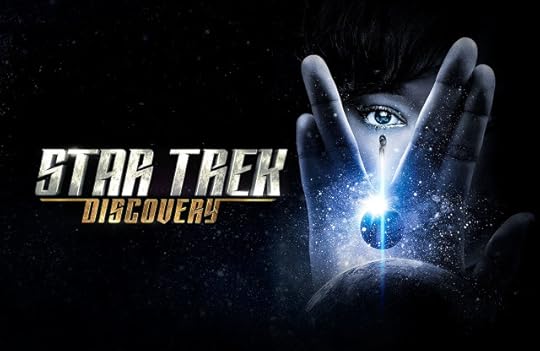 With the success of JJ Abrams’ cinematic reboot of
Star Trek
, it felt inevitable that Gene Roddenberry’s creation would return to its small-screen roots sooner rather than later. And sure enough, in 2015 CBS announced that the centrepiece of its over-the-top streaming service would be Star Trek: Discovery - another prequel to the original series (“TOS”), but this time one that would revolve around a single, previously unexplored chapter of Federation history. With a much larger budget for far fewer episodes than previous shows, not to mention the scintillating look of Abrams’ movies to draw inspiration from, the prospect was tantalising for avid Trekkers and casual moviegoers alike.
With the success of JJ Abrams’ cinematic reboot of
Star Trek
, it felt inevitable that Gene Roddenberry’s creation would return to its small-screen roots sooner rather than later. And sure enough, in 2015 CBS announced that the centrepiece of its over-the-top streaming service would be Star Trek: Discovery - another prequel to the original series (“TOS”), but this time one that would revolve around a single, previously unexplored chapter of Federation history. With a much larger budget for far fewer episodes than previous shows, not to mention the scintillating look of Abrams’ movies to draw inspiration from, the prospect was tantalising for avid Trekkers and casual moviegoers alike.

My excitement for the series’ arrival would only be tempered by it being produced exclusively for a streaming service (CBS All Access in the US, and Netflix here in the UK) and, like Abrams’ movies, produced in unpardonable (and un-future-proof) 2K. Given that other premium shows the likes of Better Call Saul and Marvel’s Daredevil are available to stream on Netflix in genuine 4K here in the UK, 1080p episodes - even when buoyed by HDR - are a real let down for a supposed state-of-the-art franchise. And as readers of this blog already know, whilst I respect streaming as a technological platform, I find most streaming services deeply flawed. They are focused on pushing quantity over quality, and a result people find themselves either having to perpetually subscribe to half a dozen different services in order to get something close to what they want or, worse, watching any old shit served up for them. I prefer to purchase the content that I actually want to watch either to stream from my media centre to my Apple TV (via the Computers app) or to watch on Ultra HD Blu-ray (I’m boycotting Apple TV 4K until such time as I can actually download my 4K iTunes purchases). But with no iTunes series pass or Blu-ray release on the horizon, Netflix finally had me snookered if I wanted to see Star Trek: Discovery within a year or so of its debut.
Yet my interest in the upcoming series couldn’t be kept down by such niggling practical concerns. Unlike many, I had persevered with tellyTrek right through to its peculiar death throes on an Enterprise-D holodeck back in 2005, and despite a few issues with its various series over the years - the weary first half of Enterprise and the utter absurdity of the fantastic Voyager premise’s execution, to name just a couple - I had remained a fan. And so as, drip by drip, information about the new series began to leak out - “It’s set in the Prime timeline!” / “The main character isn’t the captain!” / “The event is the Klingon War!” - my expectations began to swell.
Then I watched it.
Those lofty expectations were twisted and subverted... in the most captivating of ways.
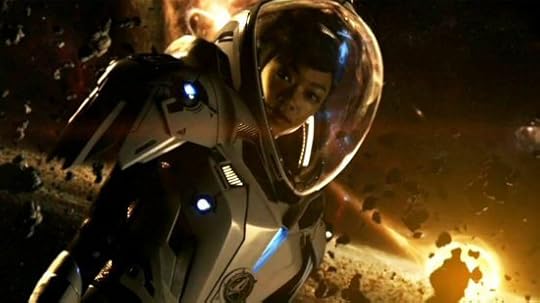
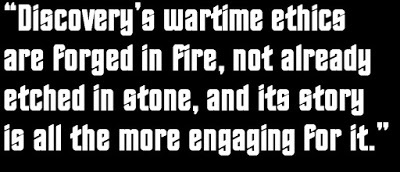 A franchise that had burned itself out through strict adherence to an outmoded episodic model, even when experiments like the ten-part
Deep Space Nine
(“DS9”) finale and Enterprise Season 3 had proved beyond doubt that Trek’s future is in serialised storytelling, had suddenly been reinvigorated. Good but still clearly TV-budget effects had been traded for full-blown, feature-film spectacle. Grit and nuance championed over predictability and procedure. Discovery is still palpably Star Trek, but with an edge all of its own. It takes camp ’60s Star Trek conceits and makes them brutal and horrifying, smashing the plot mechanics of “The Trouble with Tribbles”, for instance, into the tone of Game of Thrones, all the while infusing the material with Gene Roddenberry’s uncompromising sense of morality, if not quite his vision of a utopian future. Discovery’s wartime ethics are forged in fire, not already etched in stone, and its story is all the more engaging for it. Sonequa Martin-Green’s Michael Burnham goes through hell to get where we want her to go; she isn’t already there like the crew of Jim Kirk’s Enterprise. At times Discovery feels more like a prequel to its future self than it does to TOS, as its entire first season - not just its opening two-part prologue - shapes who its principal protagonists will become, rather than present them fully-formed in the style of every prior Star Trek TV show.
A franchise that had burned itself out through strict adherence to an outmoded episodic model, even when experiments like the ten-part
Deep Space Nine
(“DS9”) finale and Enterprise Season 3 had proved beyond doubt that Trek’s future is in serialised storytelling, had suddenly been reinvigorated. Good but still clearly TV-budget effects had been traded for full-blown, feature-film spectacle. Grit and nuance championed over predictability and procedure. Discovery is still palpably Star Trek, but with an edge all of its own. It takes camp ’60s Star Trek conceits and makes them brutal and horrifying, smashing the plot mechanics of “The Trouble with Tribbles”, for instance, into the tone of Game of Thrones, all the while infusing the material with Gene Roddenberry’s uncompromising sense of morality, if not quite his vision of a utopian future. Discovery’s wartime ethics are forged in fire, not already etched in stone, and its story is all the more engaging for it. Sonequa Martin-Green’s Michael Burnham goes through hell to get where we want her to go; she isn’t already there like the crew of Jim Kirk’s Enterprise. At times Discovery feels more like a prequel to its future self than it does to TOS, as its entire first season - not just its opening two-part prologue - shapes who its principal protagonists will become, rather than present them fully-formed in the style of every prior Star Trek TV show. 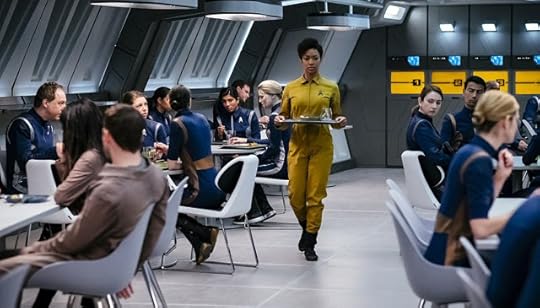
Perhaps most remarkable of all though is the show’s focus. Eschewing the done-to-death Trek trope of having the drama revolve around a crew’s most senior officers, Discovery takes its cue from the popular Next Generation (“TNG”) episode “Lower Decks”, vesting viewers’ emotions in Burnham; Anthony Rapp’s ostensibly cold but in fact warm and brilliant scientist, Stamets; his husband and, painfully at times, physician, Dr Culbert; as well as my own favourite, loveable cadet - and clearly future Discovery captain - Tilly. Mary Wiseman imbues the bumbling Starfleet hopeful with a feckless sense of wonder and optimism that screams Star Trek even when everyone else around her is permanently living under a black cloud.
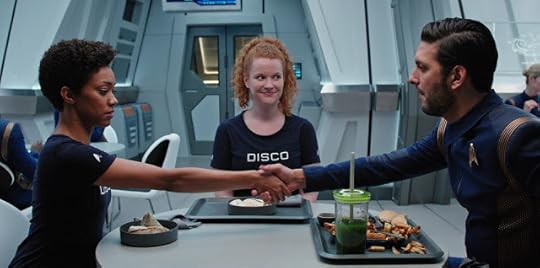 However, this is not to suggest that Discovery doesn’t flesh out those at the top of the hierarchy; quite the opposite, in fact. From Jason Isaacs’ seemingly sinister and utterly beguiling Captain Lorca to Doug Jones’ inscrutable Saru, Discovery’s heavy hitters are every bit as well drawn as their counterparts below stairs. The difference is only one of emphasis - we know who our viewpoint characters are, what they care about, and what their motives are. Saru and Lorca keep us guessing well into the season’s final furlong, and the Kelpien first officer in particular delights as he triumphantly comes into his own when the season’s disparate plot threads finally converge. He might be a slow-burning character, but he’s one who’ll have you punching the air before the season ends.
However, this is not to suggest that Discovery doesn’t flesh out those at the top of the hierarchy; quite the opposite, in fact. From Jason Isaacs’ seemingly sinister and utterly beguiling Captain Lorca to Doug Jones’ inscrutable Saru, Discovery’s heavy hitters are every bit as well drawn as their counterparts below stairs. The difference is only one of emphasis - we know who our viewpoint characters are, what they care about, and what their motives are. Saru and Lorca keep us guessing well into the season’s final furlong, and the Kelpien first officer in particular delights as he triumphantly comes into his own when the season’s disparate plot threads finally converge. He might be a slow-burning character, but he’s one who’ll have you punching the air before the season ends.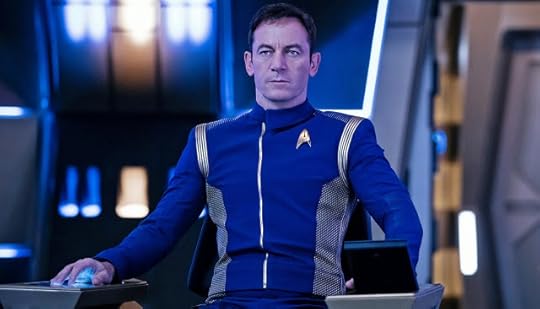 The performances of the cast are outdone only by the quality of the writing, which in my view stands up against any seen in even the most respected of modern “event” series, though this is hardly surprising with literary Voyager showrunner Kirsten Beyer and Kelvin timeline /
Transformers: Prime
alumnus Alex Kurtzman helping to steer the writers’ room. I’m particularly impressed with the writers’ ability to paint in shades of grey. Discovery is a show without heroes and villains; its battle between good and evil is fought within its characters’ hearts, be they Klingon or human... or something else altogether. From Burnham and Voq to Lorca and Cornwell, everyone is struggling to balance their own needs in the moment against what they know to be right. Just like the finest Star Trek stories over the years, the first season of Discovery is a study in ethics, but its presentation is such that it feels completely original.
The performances of the cast are outdone only by the quality of the writing, which in my view stands up against any seen in even the most respected of modern “event” series, though this is hardly surprising with literary Voyager showrunner Kirsten Beyer and Kelvin timeline /
Transformers: Prime
alumnus Alex Kurtzman helping to steer the writers’ room. I’m particularly impressed with the writers’ ability to paint in shades of grey. Discovery is a show without heroes and villains; its battle between good and evil is fought within its characters’ hearts, be they Klingon or human... or something else altogether. From Burnham and Voq to Lorca and Cornwell, everyone is struggling to balance their own needs in the moment against what they know to be right. Just like the finest Star Trek stories over the years, the first season of Discovery is a study in ethics, but its presentation is such that it feels completely original.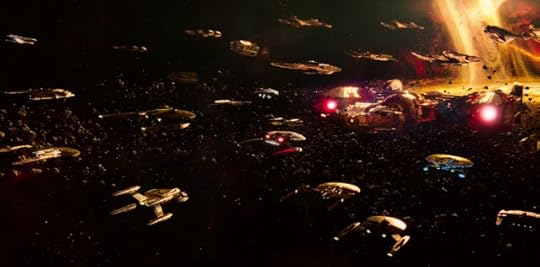
The show’s visuals are, without exception, absolutely stunning, while its breathtaking multi-channel soundtrack evokes everything from TOS’s spine-tingling opening chords to the guttural and utterly alien Klingon language of Star Trek: The Motion Picture (“TMP”) and beyond. The show’s 2:1 aspect ratio is infuriating, however, and to me smacks of pretension. Discovery isn’t a feature film; it’s produced for the express purpose of being watched at home on 16:9 TVs, and so to present it in anything other than 16:9 is to waste pixels and diminish the viewing experience.
Furthermore, as an expansion of the “Prime” Star Trek canon, which prior to Discovery comprised ten (well, ten and a bit, really) feature films and over five hundred hours’ worth of tellyTrek, Discovery is nothing if not divisive. Little things like having a Starfleet uniform closer to those seen on the NX-01 a century earlier, rather than those shown ten years hence on TOS, would be forgivable in isolation, but when considered as part of the messy whole become harder to ignore. With its spore drive and holo-comms, Discovery has technology ahead of even the Enterprise-E’s and Voyager’s, and most troublingly of all, the show completely reimagines the Klingon race.
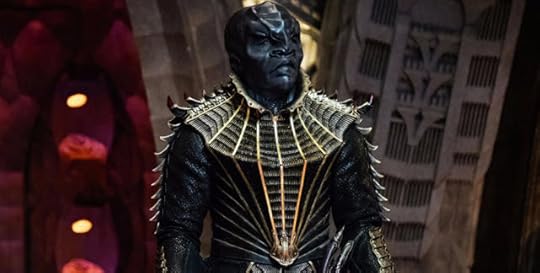
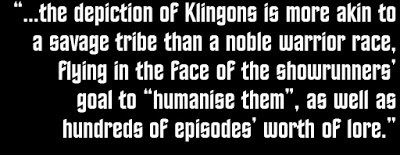 If ever there was a race that didn’t need taking back to the drawing board, it was the warriors of Q’onoS. Rather than tweak a successful and iconic look, Discovery unnecessarily reinvents the wheel, taking the race’s defining forehead ridges and getting rid of everything else: hair, beards, armour, those awesome boots; even their ships and technology, even their idiosyncratic culture, is given a page one rewrite. I think it’s fair to say that, beyond Spock and his Vulcan brethren, Klingons are the one race from Star Trek that the average person on the street would recognise - and they’d do so in their “classic” form as first seen in TMP and immortalised by TNG and DS9’s Mr Worf. When Russell T Davies resurrected
Doctor Who
, he knew better than to mess with the design of a Dalek. Bulk it up a bit, yeah; spray it bronze, fair dues; but otherwise remain true to the timeless design. Davies would have had to totally cover his Dalek with giant bumps, engorge its dome, replace its plunger with a satellite dish and redesign all of its ships and technology to fuck it up as royally as Discovery has its Klingons.
If ever there was a race that didn’t need taking back to the drawing board, it was the warriors of Q’onoS. Rather than tweak a successful and iconic look, Discovery unnecessarily reinvents the wheel, taking the race’s defining forehead ridges and getting rid of everything else: hair, beards, armour, those awesome boots; even their ships and technology, even their idiosyncratic culture, is given a page one rewrite. I think it’s fair to say that, beyond Spock and his Vulcan brethren, Klingons are the one race from Star Trek that the average person on the street would recognise - and they’d do so in their “classic” form as first seen in TMP and immortalised by TNG and DS9’s Mr Worf. When Russell T Davies resurrected
Doctor Who
, he knew better than to mess with the design of a Dalek. Bulk it up a bit, yeah; spray it bronze, fair dues; but otherwise remain true to the timeless design. Davies would have had to totally cover his Dalek with giant bumps, engorge its dome, replace its plunger with a satellite dish and redesign all of its ships and technology to fuck it up as royally as Discovery has its Klingons.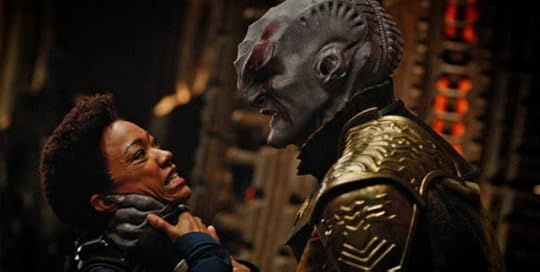 Of course, apologists argue that the Klingon look has never been consistent over the years; so much so, in fact, that in one of the thirtieth anniversary specials, Worf dryly makes a joke - insofar as he ever makes a joke - about it with Odo, Chief O’Brien and Ra’s al Ghul. Fans of the redesign also contend that as make-up and prosthetics advance, showrunners are duty-bound to have the courage to present alien races as convincingly as they can; after all, the swarthy human-looking Klingons of the original series would look ludicrous in a show with the production standards of Discovery. I have some sympathy with this viewpoint, but it ends when I consider that “classic” Klingons, particularly if embellished a little for an HD production, would sit perfectly well with Discovery’s gloss-meets-grit aesthetic. Furthermore, previous discrepancies in Klingon appearance had all been pleasingly - if not altogether convincingly- addressed within the fiction in a spellbinding Enterprise two-parter, the events of which Discovery retrospectively renders preposterous. Finally, and perhaps most critically, the depiction of Klingons in Discovery is more akin to a savage tribe than a noble warrior race, completely flying in the face of the showrunners’ publicly-declared goal to “humanise them”, as well as hundreds of episodes’ worth of lore.
Of course, apologists argue that the Klingon look has never been consistent over the years; so much so, in fact, that in one of the thirtieth anniversary specials, Worf dryly makes a joke - insofar as he ever makes a joke - about it with Odo, Chief O’Brien and Ra’s al Ghul. Fans of the redesign also contend that as make-up and prosthetics advance, showrunners are duty-bound to have the courage to present alien races as convincingly as they can; after all, the swarthy human-looking Klingons of the original series would look ludicrous in a show with the production standards of Discovery. I have some sympathy with this viewpoint, but it ends when I consider that “classic” Klingons, particularly if embellished a little for an HD production, would sit perfectly well with Discovery’s gloss-meets-grit aesthetic. Furthermore, previous discrepancies in Klingon appearance had all been pleasingly - if not altogether convincingly- addressed within the fiction in a spellbinding Enterprise two-parter, the events of which Discovery retrospectively renders preposterous. Finally, and perhaps most critically, the depiction of Klingons in Discovery is more akin to a savage tribe than a noble warrior race, completely flying in the face of the showrunners’ publicly-declared goal to “humanise them”, as well as hundreds of episodes’ worth of lore.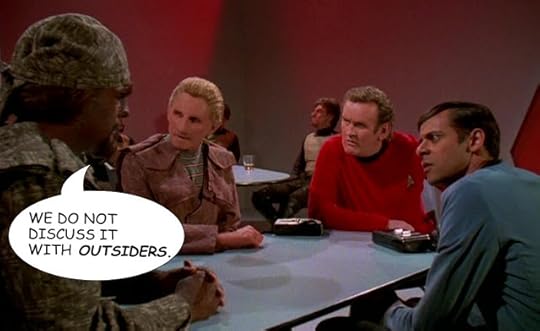 Those diplomatically seeking to unify this new show that they’ve fallen in love with with their cherished canon assert, their bunched fists haemorrhaging straw, that Discovery’s Klingons are an isolated sub-species of the race, which could explain not only their bizarre appearance but also their unfamiliar ships and tech. Now the show could have got away with allowing us to infer this, admittedly at the risk of perplexing new viewers, had the representatives of the twenty-four Klingon houses been comprised of some “classic” and human-looking Klingons too. As it is, Kurtzman is going to have to come up with something mind-bogglingly inventive to be able to reconcile the hirsute Klingons (which I gather we’re due to see in Discovery Season 2) with the first season’s sensory-organs-on-the-backs-of-their-head troupe. The only logical, semi-plausible option that I see is to have Discovery’s Klingon houses breed with TOS’s human-looking Klingons to (re)create the race’s “classic” look in time for TMP (though we really don’t need to see them actually going at it this time. I’m still having nightmares about L’Rell in the niff).
Those diplomatically seeking to unify this new show that they’ve fallen in love with with their cherished canon assert, their bunched fists haemorrhaging straw, that Discovery’s Klingons are an isolated sub-species of the race, which could explain not only their bizarre appearance but also their unfamiliar ships and tech. Now the show could have got away with allowing us to infer this, admittedly at the risk of perplexing new viewers, had the representatives of the twenty-four Klingon houses been comprised of some “classic” and human-looking Klingons too. As it is, Kurtzman is going to have to come up with something mind-bogglingly inventive to be able to reconcile the hirsute Klingons (which I gather we’re due to see in Discovery Season 2) with the first season’s sensory-organs-on-the-backs-of-their-head troupe. The only logical, semi-plausible option that I see is to have Discovery’s Klingon houses breed with TOS’s human-looking Klingons to (re)create the race’s “classic” look in time for TMP (though we really don’t need to see them actually going at it this time. I’m still having nightmares about L’Rell in the niff).Ultimately Star Trek: Discovery lives or dies by how you look at it. As a new, fifteen-part serial produced for a modern audience, it is hard to see it as anything other than a resounding success. As a prequel charged with enriching a pre-existing universe, however, it fails in its duty. But if its first season has taught us anything, it’s that nobody and nothing is beyond redemption...
Star Trek: Discovery is available to stream in 1080p HDR on Netflix. A Season 1 Blu-ray steelbook is available to pre-order from Zavvi for £34.99. There is no word on an iTunes digital release as yet, but this is likely to be concurrent with the physical release.
Published on August 27, 2018 07:58
December 29, 2017
Film Reviews | Star Wars: The Last Jedi directed by Rian Johnson
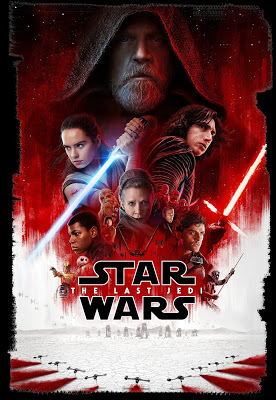 This review is not going to go the way you think. I’m not going to condemn Rian Johnson’s anti-holistic, geek-aggravating approach to
Star Wars
; nor am I going to bemoan supposed plot holes that don’t even come close to rivalling Obi-Wan’s unlikely scheme to “hide” Darth Vader’s son on his home planet with his step family (and without even bothering to change his surname!) upon which the original trilogy was built. Instead, I’m going to whinge about how I had to sit for almost three hours next to a broken speaker which hissed at about 95dB whenever Poe Dameron so much as looked at an X-Wing. Like the other hundred or so people in the screening, I couldn’t get up to go and complain in case I missed anything, so I just had to sit there, my stomach in knots, the best afternoon of my year ruined from the start.
This review is not going to go the way you think. I’m not going to condemn Rian Johnson’s anti-holistic, geek-aggravating approach to
Star Wars
; nor am I going to bemoan supposed plot holes that don’t even come close to rivalling Obi-Wan’s unlikely scheme to “hide” Darth Vader’s son on his home planet with his step family (and without even bothering to change his surname!) upon which the original trilogy was built. Instead, I’m going to whinge about how I had to sit for almost three hours next to a broken speaker which hissed at about 95dB whenever Poe Dameron so much as looked at an X-Wing. Like the other hundred or so people in the screening, I couldn’t get up to go and complain in case I missed anything, so I just had to sit there, my stomach in knots, the best afternoon of my year ruined from the start. Or so I’d thought.
It was at least some consolation that The Last Jedi lived up to the critical acclaim instantly bestowed upon it - even with half its awesome battles drowning in static and interference.
JJ Abrams had a difficult enough task remixing and updating the original Star Wars movie for a new generation as The Force Awakens , but Rian Johnson’s mission to do the same for The Empire Strikes Back was altogether more problematical. Now almost universally celebrated for its darker tone; peerless villain; rough-and-ready space romance; and saga-shattering twist, my favourite Star Wars movie – no, my favourite movie - could not simply be reworked for a modern audience as A New Hope was. Not without being utterly predictable, anyway, which in of itself would make it unlike Empire . Yes, Johnson could use Episode V ’s basic heroes-on-the-run / young-Jedi-wannabe-in-search-of-guidance premise, but ultimately the only way to replicate the sense of shock and awe that Empire engendered was to turn it on its head - and that’s exactly what Johnson’s game-changing middle act does.
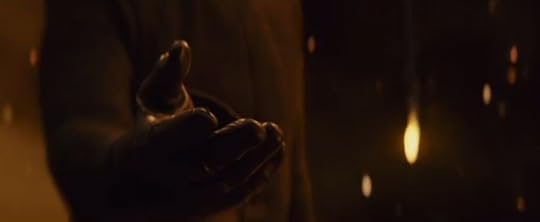 “You’re nobody. You have no place in this story. You’re nothing. But not to me.”
“You’re nobody. You have no place in this story. You’re nothing. But not to me.”The Last Jedi’s twists and turns don’t even strike when you expect. Arguably the movie’s seminal scene sits just off-centre, rather than at its end. The Last Jedi makes fine art of toying with audience expectations, only to shatter them, leaving viewers feeling almost exactly as they did the first time that they heard Darth Vader claim, “I am your father.” Only this time, the twist is that Rey’s parents weren’t galactic despots conceived by the Force - our scrappy scavenger’s place in the story is not earned through her provenance but her heroic actions, and the saga is all the more thrilling for it. We’ve always known that anybody can be strong in the Force, but to see such “raw strength” under the microscope really drives home Johnson’s message that anyone has the potential to be anything, irrespective of their background or heredity. He may hit that particular note a little too often, the movie’s final scene being a case in point, but given where we leave the Resistance I can understand the desire to show how events on Crait have already begun to resonate amongst the galaxy’s oppressed.

Those who’ve lambasted Episode VIII because they aren’t happy with Rey’s lineage are too focused on the minutiae of the original trilogy to recognise its spirit: the mechanics of this movie, and indeed the sequel trilogy thus far, remain the same. Luke entered Yoda’s cave in Empire and saw himself in Vader’s armour, because what he feared most was falling to the dark side. Rey was abandoned, she’s no-one, and so the depths of Acho-To’s showed her endless reflections of herself, bringing her solitude into sharp focus and strengthening her resolve. The Last Jedi serves its protagonist’s character exactly as Empire did its own, and in so doing retrospectively enriches the film which it follows.
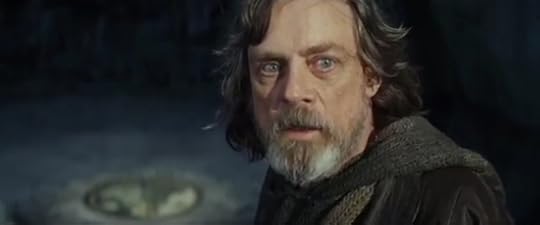 “I’ve seen this raw strength only once before, in Ben Solo. I wasn’t frightened enough then. I am now.”
“I’ve seen this raw strength only once before, in Ben Solo. I wasn’t frightened enough then. I am now.” This notwithstanding, going into the movie I was looking forward to catching up with a certain Skywalker more than anything else. The film’s mouth-watering trailers had painted the picture of Luke as a broken man who’s given up on all that he’s ever believed in, but, true to form, The Last Jedi fleshes this out in the most astonishing and inventive of ways. When we meet him, Luke has literally lost his religion, having cut himself off from the Force. Where there was once youthful exuberance, now there is only caustic humour and cynicism. Where there was once hope, there is only fear. Luke Skywalker has become an even more reluctant Yoda, almost an anti-Obi-Wan. He’s prickly, cold and tormented by the thought that he lost his nephew to the dark side. The beats of the original trilogy are still there, only heightened. Obi-Wan lost a brother-in-arms to evil. He perhaps let him down, but he wasn’t ultimately to blame. Luke lost actual family, and what’s eating him up is that he was directly responsible. That famous insight which served him so well in
A New Hope
and
Return of the Jedi
caused a momentary lapse of reason that left him, and the galaxy at large, with “consequence”. Despite his public reservations about the script, Mark Hamill’s returning performance is nothing short of mercurial. He may not have bought into Luke’s story when he read the script, but he certainly sells it on screen. Hands down, Episode VIII is Hamill’s finest turn.
This notwithstanding, going into the movie I was looking forward to catching up with a certain Skywalker more than anything else. The film’s mouth-watering trailers had painted the picture of Luke as a broken man who’s given up on all that he’s ever believed in, but, true to form, The Last Jedi fleshes this out in the most astonishing and inventive of ways. When we meet him, Luke has literally lost his religion, having cut himself off from the Force. Where there was once youthful exuberance, now there is only caustic humour and cynicism. Where there was once hope, there is only fear. Luke Skywalker has become an even more reluctant Yoda, almost an anti-Obi-Wan. He’s prickly, cold and tormented by the thought that he lost his nephew to the dark side. The beats of the original trilogy are still there, only heightened. Obi-Wan lost a brother-in-arms to evil. He perhaps let him down, but he wasn’t ultimately to blame. Luke lost actual family, and what’s eating him up is that he was directly responsible. That famous insight which served him so well in
A New Hope
and
Return of the Jedi
caused a momentary lapse of reason that left him, and the galaxy at large, with “consequence”. Despite his public reservations about the script, Mark Hamill’s returning performance is nothing short of mercurial. He may not have bought into Luke’s story when he read the script, but he certainly sells it on screen. Hands down, Episode VIII is Hamill’s finest turn.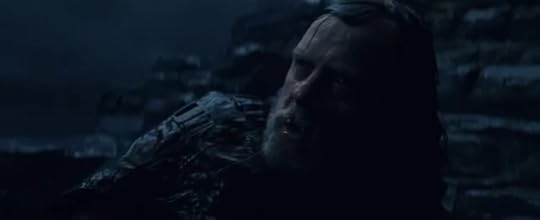 I also applaud Johnson for having the gumption to make Luke accept the bare truth of what George Lucas would only dare to imply in his prequels. The Jedi are every bit as flawed as the Sith, at least as an institution, and were their order to endure the consequence would be a slew of Darth Vaders and Kylo Rens unleashed upon the galaxy. We already know how the Jedi Order’s mistreatment of Anakin Skywalker fuelled his descent into evil, and what The Last Jedi reveals of Ben Solo’s journey to the dark side is even more damning. Life and death, light and dark - the Force seeks balance, as Johnson so beautifully demonstrates. But such a notion is anathema to Jedi and Sith alike. Perhaps Luke’s epiphany that the Jedi Order must end – a view apparently endorsed by a very old and wise friend who makes a welcome return - will give rise to a new generation of Force-wielders who are not restrained by the “narrow, dogmatic” constraints of the Jedi Order or the self-defeating greed of the Sith. In 1977 good guys wore white, and villains black. For better or worse, 2017 is altogether greyer. Rigid notions of sexuality, gender and even morality are constantly shifting, and so it’s fitting that the sequel trilogy’s two central figures are reflective of this cultural blurring of the lines.
I also applaud Johnson for having the gumption to make Luke accept the bare truth of what George Lucas would only dare to imply in his prequels. The Jedi are every bit as flawed as the Sith, at least as an institution, and were their order to endure the consequence would be a slew of Darth Vaders and Kylo Rens unleashed upon the galaxy. We already know how the Jedi Order’s mistreatment of Anakin Skywalker fuelled his descent into evil, and what The Last Jedi reveals of Ben Solo’s journey to the dark side is even more damning. Life and death, light and dark - the Force seeks balance, as Johnson so beautifully demonstrates. But such a notion is anathema to Jedi and Sith alike. Perhaps Luke’s epiphany that the Jedi Order must end – a view apparently endorsed by a very old and wise friend who makes a welcome return - will give rise to a new generation of Force-wielders who are not restrained by the “narrow, dogmatic” constraints of the Jedi Order or the self-defeating greed of the Sith. In 1977 good guys wore white, and villains black. For better or worse, 2017 is altogether greyer. Rigid notions of sexuality, gender and even morality are constantly shifting, and so it’s fitting that the sequel trilogy’s two central figures are reflective of this cultural blurring of the lines. “Let the past die. Kill it, if you have to. It’s the only way to become what you were meant to be.”
“Let the past die. Kill it, if you have to. It’s the only way to become what you were meant to be.” But only the fan fictioneers who first dreamt up the idea of “ForceTime” foresaw the startling direction that The Last Jedi would take, although I daresay that even they were left reeling by how their idea would impact upon the saga’s two main players. Unwillingly connected through the Force across the galaxy, Rey and Kylo Ren find themselves bound to one another as effectively as if they were locked up together in a holding cell. Through Johnson’s ingeniously simple cuts, what begins as a jarring and slightly surreal interstellar dialogue soon develops into something as solid as a single-set scene. As walls of enmity and privacy fall, we start to see the glimmer of a mutual understanding and sympathy between our two adversaries; perhaps even affection. Rey starts to see the light in the dark, and Ren the darkness in the light. More so than with the planet-destroying, son-maiming Darth Vader, I found myself willing for this poor lost boy’s soul to be saved.
But only the fan fictioneers who first dreamt up the idea of “ForceTime” foresaw the startling direction that The Last Jedi would take, although I daresay that even they were left reeling by how their idea would impact upon the saga’s two main players. Unwillingly connected through the Force across the galaxy, Rey and Kylo Ren find themselves bound to one another as effectively as if they were locked up together in a holding cell. Through Johnson’s ingeniously simple cuts, what begins as a jarring and slightly surreal interstellar dialogue soon develops into something as solid as a single-set scene. As walls of enmity and privacy fall, we start to see the glimmer of a mutual understanding and sympathy between our two adversaries; perhaps even affection. Rey starts to see the light in the dark, and Ren the darkness in the light. More so than with the planet-destroying, son-maiming Darth Vader, I found myself willing for this poor lost boy’s soul to be saved. “You’re no Vader. You’re just a child in a mask.”
I would never have believed that anyone could make a movie that would have me championing the man who killed Han Solo, but as The Last Jedi’s unbelievable throne room gathered pace, that’s exactly what I did. Had Ben Solo finally seen the light? Would Rey succumb to the dark? As if Kylo Ren’s impromptu assassination of his scathing master, the supreme leader of the First Order, wasn’t enough to send shockwaves through cinemas everywhere, within moments he and Rey would fight back-to-back against Snoke’s guards; Rey would even put her lightsaber in his hand. But that same lightsaber - the legendary weapon forged by Anakin and passed onto Luke by Obi-Wan before being drawn to Rey - would soon be torn in half by the Force as the momentary allies resumed their opposing positions. We’re well past the passing of the torch now; that torch has been torn in half. Luke Skywalker set the stage himself in his very first act of the film.
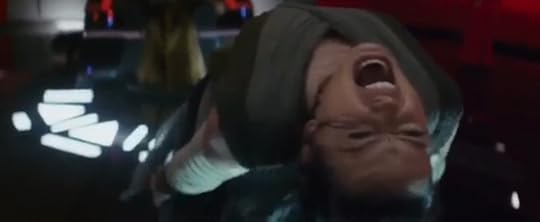
The newly-minted Supreme Leader Ren’s refusal to redeem himself is more heartbreaking, in many ways, than Anakin’s Episode III heel turn. It’s almost cruel, given what has just been played out, and therein lies its genius. Whilst Kylo Ren may lack his grandfather’s awe-inspiring presence, his evident humanity is capable of reeling in not just the audience but his adversaries too, and through it he’s accomplished what Darth Vader never could: he rules the galaxy. It’s a testament to how thoroughly transfixing both Daisy Ridley’s and Adam Driver’s performances are that their unique relationship eclipses the long-awaited return of a legend and the final appearance of another. The Last Jedi is dominated by “Reylo”, and if the same proves to be true of 2019’s Episode IX, then it has the potential to be the best of the saga - though I can’t see another director ever making a Star Wars movie that’s more visually arresting than this one. The Last Jedi is relentlessly breathtaking.
 Those who go to see Carrie Fisher’s final performance won’t be disappointed, either. Her role is perhaps more understated than many would have hoped, given that The Last Jedi has proven to be Leia’s final adventure, at least on the silver screen, but it’s significant in more ways than one. Johnson definitely made the right call in not restructuring his movie to kill off Leia following the actress’s sudden death - he certainly had the raw footage to be able to do so, and for several long moments I even thought that he had. But in keeping Leia alive, in allowing her to play out her angle with Holdo and Poe as was always intended, and particularly in reuniting her with her brother to provide the few surviving rebels with the spark of hope that they so desperately need, Johnson has given Leia a send-off that is emblematic of her character’s role in the saga, if not quite the resolute ending that both character and performer deserved. There’ll always be threads hanging, now - it’s absolutely gutting to think that we’ll never get to see her nascent Force powers fully awakened on the big screen - but with books and CG TV shows there is always the possibility that Leia’s final story will be told in another medium one day.
Those who go to see Carrie Fisher’s final performance won’t be disappointed, either. Her role is perhaps more understated than many would have hoped, given that The Last Jedi has proven to be Leia’s final adventure, at least on the silver screen, but it’s significant in more ways than one. Johnson definitely made the right call in not restructuring his movie to kill off Leia following the actress’s sudden death - he certainly had the raw footage to be able to do so, and for several long moments I even thought that he had. But in keeping Leia alive, in allowing her to play out her angle with Holdo and Poe as was always intended, and particularly in reuniting her with her brother to provide the few surviving rebels with the spark of hope that they so desperately need, Johnson has given Leia a send-off that is emblematic of her character’s role in the saga, if not quite the resolute ending that both character and performer deserved. There’ll always be threads hanging, now - it’s absolutely gutting to think that we’ll never get to see her nascent Force powers fully awakened on the big screen - but with books and CG TV shows there is always the possibility that Leia’s final story will be told in another medium one day.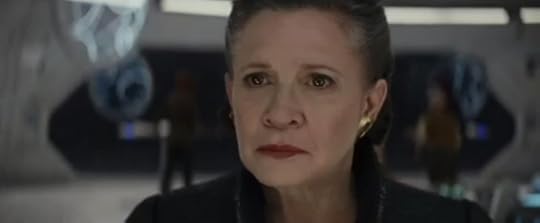
In keeping with The Last Jedi’s spirit, what I liked most about Leia’s storyline was, in fact, Poe’s. Just as Luke’s character services Rey’s, Leia’s does Poe’s, and she does so in the most maternal of ways. I loved Oscar Isaac’s character right from his dry, “Who talks first?” line in The Force Awakens, and he’s just as quick to endear himself to Last Jedi viewers with his “Holding for General Hux” skit here. What follows, though, is an absorbing examination of heroism and heedlessness unlike anything ever before seen in a Star Wars movie. Again, Johnson turns the narrative on its head, using the audience’s connection with Poe to get us on his side, only for the angry matriarch of the Resistance to rise from her sick bed to slap him down, and teach him a lesson you can’t help but feel she wished her late husband had learned long ago.
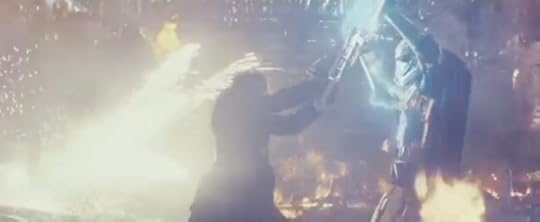 “Bad guys, good guys, it’s all a machine. Live free. Don’t join.”
“Bad guys, good guys, it’s all a machine. Live free. Don’t join.”I’m as much a fan of John Boyega’s Finn as I am Oscar Isaac’s Poe, and so I was delighted to see him paired up with a new foil - Kelly Marie Tran’s delightful Rose - and sent off on a hyperspace caper to Canto Bight in search of The Last Jedi’s answer to Lando Calrissian. This limb of the narrative seems to have been singled out for especial criticism by many, largely because it feels a little extraneous and doesn’t ultimately bear fruit within the story. Why send off Finn with Rose to find a master code breaker, when the script could have had a Resistance techie break the code in seconds? Why bother to break the code at all, when the Resistance has had another plan in the works all along? Well, for one, we get to see Finn and Rose bond, setting up a touching sequence in the Battle of Crait that will doubtless resonate into Episode IX. For another, without it Poe’s mutiny wouldn’t have had any purpose. Through Benicio Del Toro’s DJ, the director is able to explore the movie’s themes of perspective and morality in greater depth, and often explicitly. He’s able to have Finn battle Phasma again. To play tricks with irons that are both funny and dazzling. Best of all, he is able to pull the rug from under us again as, just for kicks, The Last Jedi’s answer to Lando actually does “do a Lando”.
There are, however, a couple of aspects that don’t sit well with me. The Last Jedi’s flashback scenes felt considerably out of place in a Star Wars movie, for instance. I can see why Johnson felt it appropriate to include them, given the lack of room for a “sequel prequel” trilogy (though I suppose there’s always the possibility of a bridging “ Star Wars Story” or two), and the need to relay a key historical event from two opposing perspectives, but to me they killed a little of that distinguishing Star Wars feel, and worse still they closed the circle a little too neatly. Having Luke and Ren simply tell their sides of the story would have been enough for me - Alec Guiness’s tales of Darth Vader’s dark deeds in A New Hope didn’t need any visual embellishment (though George Lucas will probably work in some prequel clips on the inevitable 4K release, if he still has the power to).
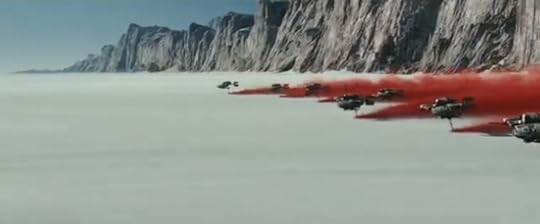 My main concern though was the lack of an intimate, one-on-one lightsaber duel. I appreciate that the timing wasn’t right for another Rey / Ren showdown, but I do think that Luke could have been given some actual action. He doesn’t – can’t, in the circumstances – clash sabers with Ren. The film’s finale is clever, uplifting and - of course - surprising, but it does feel like a bit of a cheat, even if it does prove to be the cheat that lights the spark that starts the fire that will burn the First Order down.
My main concern though was the lack of an intimate, one-on-one lightsaber duel. I appreciate that the timing wasn’t right for another Rey / Ren showdown, but I do think that Luke could have been given some actual action. He doesn’t – can’t, in the circumstances – clash sabers with Ren. The film’s finale is clever, uplifting and - of course - surprising, but it does feel like a bit of a cheat, even if it does prove to be the cheat that lights the spark that starts the fire that will burn the First Order down.Finally, I’m on the fence when it comes to Force ghosts’ apparent ability to physically interact with the living. I expect to be sold on the idea eventually, but at the moment we are missing too many pieces of the puzzle to be able to form a view. In the first Star Wars movie, Obi-Wan told Vader that if he struck him down, he’d become “more powerful than you could ever imagine”, only to return as a Force ghost and concede to Luke that he couldn’t interfere in his tangle with Vader. The question is why? Is it matter of ability, or ethics? Is it OK to burn down a tree, even a holy one, so long as you don’t use your ghostly powers to bring about regime change? Do you get Daniel Jackson-ed if you cross the line? Even with what we’ve learned from Star Wars: The Clone Wars and Star Wars Rebels , Force ghosts are still largely a mystery, but now that we’ve seen Yoda wield lightning from beyond the grave, Episode IX is going to have to examine some basic cans and can’ts.
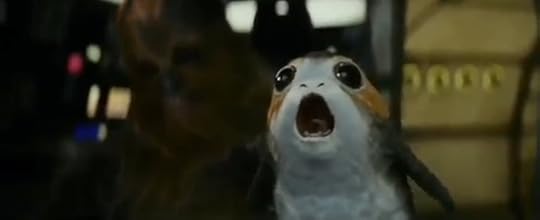
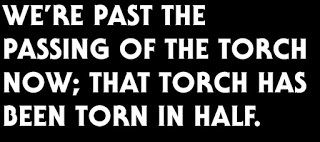 But as for comedy, Porgs and Fathiers - I really couldn’t give a damn.
Star Wars
movies are always funny – well, except Episode III – and this is a fundamental part of what makes them so universally enjoyable. All The Last Jedi does is shift gears – its humour is more modern, but no less pleasing for it. Luke’s dryness works particularly well, as does Finn’s slapstick and Chewie’s Porg problem. I don’t have any issue with the movie’s supposed diversity, either – well, except that it’s illusory. Besides Snoke, and of course BB-8, the token droid, every single member of the core ensemble is human! Chewbacca the Wookie and the other droids have about three minutes’ collective screen time, and poor old Admiral Ackbar is killed off in less than that and replaced with a human, even if it is one with purple hair. I don’t even lament the lack of a back story for Snoke – he’s just a cipher. A wonderfully played and astonishingly realised cipher, aye, but ultimately one whose origins are best explored elsewhere. Even the evil Emperor had to wait fifteen years for his tale to be told in The Phantom Menace.
But as for comedy, Porgs and Fathiers - I really couldn’t give a damn.
Star Wars
movies are always funny – well, except Episode III – and this is a fundamental part of what makes them so universally enjoyable. All The Last Jedi does is shift gears – its humour is more modern, but no less pleasing for it. Luke’s dryness works particularly well, as does Finn’s slapstick and Chewie’s Porg problem. I don’t have any issue with the movie’s supposed diversity, either – well, except that it’s illusory. Besides Snoke, and of course BB-8, the token droid, every single member of the core ensemble is human! Chewbacca the Wookie and the other droids have about three minutes’ collective screen time, and poor old Admiral Ackbar is killed off in less than that and replaced with a human, even if it is one with purple hair. I don’t even lament the lack of a back story for Snoke – he’s just a cipher. A wonderfully played and astonishingly realised cipher, aye, but ultimately one whose origins are best explored elsewhere. Even the evil Emperor had to wait fifteen years for his tale to be told in The Phantom Menace.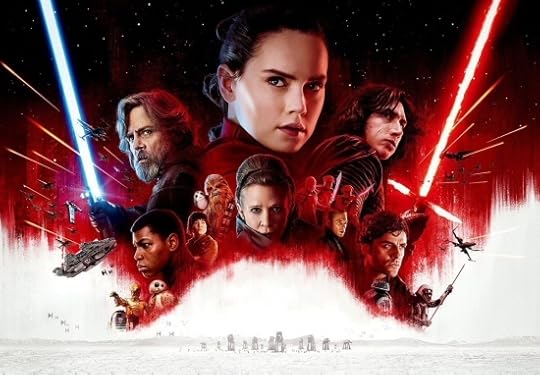 “The Rebellion is reborn. The war is just beginning. And I am not the last Jedi.”
“The Rebellion is reborn. The war is just beginning. And I am not the last Jedi.”At its most basic, telling a story is a simple as being able to say, “...and then.” A leads to B, B leads to C, and so on. Rian Johnson doesn’t do that. For every “and then”, there’s a “but.” Johnson’s movie has earned its place as the Empire of the sequel trilogy through not being it, which is exactly what the franchise needed after the awesome-but-familiar Episode VII . To some, the Star Wars movies may not quite “rhyme” as they once did anymore, but there’s no disputing that they pack more of a punch for it. And to fans lamenting Rey’s place outside the Skywalker / Solo family, think on this: there’s always marriage.
Published on December 29, 2017 12:11
November 4, 2017
Discs' Champion | Cinema Paradiso: Even Better Than LOVEFiLM?
On Halowe’en night, as the clock struck midnight, LOVEFiLM quietly disappeared. Another victory for streaming, and perhaps the heaviest loss yet for physical media.
Now my position on the old, “Why do we still bother with physical media?” debate is quite complicated. On the one hand, I concede that it’s moribund – and deservedly so. Some people might still like tangible things, but downloading or streaming digital media is faster, greener and takes up negligible real-world space. It didn’t really hit me until I moved house in 2012 just how many shiny discs and plastic cases I owned - I’ve since eBayed the collection down to just three titles, all of them Blu-ray steelbooks, and two of them still in their shrink wrap as I can watch their digital counterparts on Apple TV. There’s simply no need in this day and age to deliver digital media by disc – not when video can be downloaded and streamed in glorious 4K HDR. I’ve even given up fully on printed books, now, having recently read a number of DC graphic novels on the iPad in the iBooks app with no more difficulty than I would the trade paperbacks. Less, in fact, as this way I can read in bed again without having to disturb my wife with a bedside lamp.
On the other hand, though, subscription streaming services are all lacking in content, and it’s here that the apparently black-and-white issue becomes cloudier for me. Amazon Prime Video, Netflix, et al are so convenient and relatively inexpensive that people are now content to just lazily watch whatever old shite is offered up, provided that once in a while a decent original series comes along to justify keeping the subscription. Why go to the trouble of sourcing the 1970s Famous Five TV series on DVD for an Enid Blyton-obsessed daughter, when you can just bombard her with three of five Peppa Pig seasons on an endless Netflix loop? Why spend a fortune on Game of Thrones, when you can just watch Breaking Bad for a ninth time?
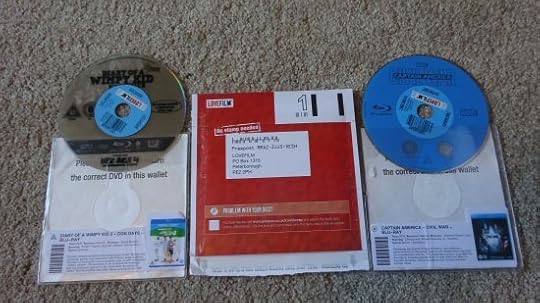
LOVEFiLM survived and thrived for as long as it did because its content library was vast, encompassing almost all mainstream movies and TV shows, and quite a few niche selections to boot. Yes, the content wasn’t available on demand, but it was worth waiting for – it was part of the fun, really. My eldest daughter used to get quite excited when she’d hear the letterbox go and the discs land on the mat. That’s much healthier, in my view, than having her stare blankly into an iPad. I’ve just cancelled my free Netflix trial with a fortnight left to run because, beyond the exclusive Star Trek: Discovery, anything else on there worth watching I’ve either seen through LOVEFiLM or own in my iTunes library. Amazon Prime Video didn’t even last that long in our house.
And, as much as I champion iTunes and Apple TV, they don’t always have the content that I want to buy. Mostly they do, in fairness, and almost always before the physical releases arrive - this year all the CW’s superhero shows hit the iTunes Store several months ahead of their physical releases, for instance, and almost every major motion picture is released a good few weeks in advance of its various discs hitting stores. However, a show like Gotham , which had its highly-regarded third season released on Blu-ray and DVD in August, still hasn’t been released in the iTunes Store because it’s yet to air in the UK, while some older shows are available, but not in HD despite having had a Blu-ray release – the 2005-2008 seasons of Doctor Who are cases in point. And, of everything that I do buy, I normally have to re-tag it as the metadata is riddled with typos or other errors, and the cover art has often been clumsily adapted to fit Apple’s size requirements or simply doesn’t measure up to the physical media’s artwork. I get the impression that printed sleeves are carefully designed, proofed and vetted by media distributors – uploaded files clearly are not. When I purchased Transformers: The Last Knight from the iTunes Store recently even its title wasn’t correct – it had a superfluous “(Digital)” at the end, as if this wasn’t the norm. Worse, if you purchase a bundle of movies without numbers in their titles like, say, the Star Wars six-movie collection, the films don’t automatically show up in your library in the correct order. It may be easy to remedy (simply change the “sort as” field in iTunes to “Star Wars 1”, “Star Wars 2” etc), and indeed to forgive (particularly now iTunes are offering free 4K HDR upgrades of movies to customers who bought them in 1080p) but it’s still sloppy and would not have passed muster on disc.
In short, then, the technology is wonderful, but the content platforms are not. To bend what’s available to my requirements, I have needed to buy what I want to keep from iTunes and rent things that I think we’ll only watch once through LOVEFiLM (and if I’m wrong, and they do warrant a repeat viewing, use the superb CheapCharts app to price-watch them on iTunes so that I can nab them when they’re more reasonably priced). But with LOVEFiLM gone, I’ve had to scour the market for a replacement service, and it seems that there is only one: Cinema Paradiso, which is basically a better version of LOVEFiLM. Yes, better.

 Cinema Paradiso offers tens of thousands more titles than its erstwhile Amazon-run competitor did, and allocates them more efficiently. There are no “High” and “Low” priority titles with Cinema Paradiso – you rank your titles in the order that you want them posted out to you, and in my case I’ve had the top two titles on my list with every despatch thus far. And they weren’t mainstream picks either; my first two discs were the incredibly rare Droids and Ewoks DVDs that Lucasfilm released about forty-three copies of back in 2005 (and which iTunes don’t appear to offer a digital version of). These were on my LOVEFiLM list for six years as “High”-priority titles, yet I was never sent them.
Cinema Paradiso offers tens of thousands more titles than its erstwhile Amazon-run competitor did, and allocates them more efficiently. There are no “High” and “Low” priority titles with Cinema Paradiso – you rank your titles in the order that you want them posted out to you, and in my case I’ve had the top two titles on my list with every despatch thus far. And they weren’t mainstream picks either; my first two discs were the incredibly rare Droids and Ewoks DVDs that Lucasfilm released about forty-three copies of back in 2005 (and which iTunes don’t appear to offer a digital version of). These were on my LOVEFiLM list for six years as “High”-priority titles, yet I was never sent them.
So far I’ve had fewer problems with unplayable discs too – the discs that I’ve received have all been pristine. How much this is to do with the material (instead of plastic) slipcases that house the disc, I don’t know, but the end result is perfect. The discs aren’t even branded with bulky Cinema Paradiso stickers the way that LOVEFiLM’s discs were, and as a result you can actually read all the information on the discs, which is more important than you’d think in the absence of the cover.

The return envelopes provided are exactly the same as LOVEFiLM’s, bar the printing, though there is one key difference between the two services where Cinema Paradiso comes off worse: there’s no app. The Cinema Paradiso website may be stylish and easy to navigate, but an app would still be welcome as, if nothing else, it’d avoid the need to log in every time I need to add or remove a title from my list.
So, in an imperfect world full of wondrous platforms that continue to pedal utter shite, clunky old physical media still has a champion: Cinema Paradiso, where the content comes first, not the platform. And after all, isn’t it the content that matters? People seem to be forgetting…
Cinema Paradiso are currently offering a fourteen-day, no-obligation free trial .
Now my position on the old, “Why do we still bother with physical media?” debate is quite complicated. On the one hand, I concede that it’s moribund – and deservedly so. Some people might still like tangible things, but downloading or streaming digital media is faster, greener and takes up negligible real-world space. It didn’t really hit me until I moved house in 2012 just how many shiny discs and plastic cases I owned - I’ve since eBayed the collection down to just three titles, all of them Blu-ray steelbooks, and two of them still in their shrink wrap as I can watch their digital counterparts on Apple TV. There’s simply no need in this day and age to deliver digital media by disc – not when video can be downloaded and streamed in glorious 4K HDR. I’ve even given up fully on printed books, now, having recently read a number of DC graphic novels on the iPad in the iBooks app with no more difficulty than I would the trade paperbacks. Less, in fact, as this way I can read in bed again without having to disturb my wife with a bedside lamp.
On the other hand, though, subscription streaming services are all lacking in content, and it’s here that the apparently black-and-white issue becomes cloudier for me. Amazon Prime Video, Netflix, et al are so convenient and relatively inexpensive that people are now content to just lazily watch whatever old shite is offered up, provided that once in a while a decent original series comes along to justify keeping the subscription. Why go to the trouble of sourcing the 1970s Famous Five TV series on DVD for an Enid Blyton-obsessed daughter, when you can just bombard her with three of five Peppa Pig seasons on an endless Netflix loop? Why spend a fortune on Game of Thrones, when you can just watch Breaking Bad for a ninth time?

LOVEFiLM survived and thrived for as long as it did because its content library was vast, encompassing almost all mainstream movies and TV shows, and quite a few niche selections to boot. Yes, the content wasn’t available on demand, but it was worth waiting for – it was part of the fun, really. My eldest daughter used to get quite excited when she’d hear the letterbox go and the discs land on the mat. That’s much healthier, in my view, than having her stare blankly into an iPad. I’ve just cancelled my free Netflix trial with a fortnight left to run because, beyond the exclusive Star Trek: Discovery, anything else on there worth watching I’ve either seen through LOVEFiLM or own in my iTunes library. Amazon Prime Video didn’t even last that long in our house.
And, as much as I champion iTunes and Apple TV, they don’t always have the content that I want to buy. Mostly they do, in fairness, and almost always before the physical releases arrive - this year all the CW’s superhero shows hit the iTunes Store several months ahead of their physical releases, for instance, and almost every major motion picture is released a good few weeks in advance of its various discs hitting stores. However, a show like Gotham , which had its highly-regarded third season released on Blu-ray and DVD in August, still hasn’t been released in the iTunes Store because it’s yet to air in the UK, while some older shows are available, but not in HD despite having had a Blu-ray release – the 2005-2008 seasons of Doctor Who are cases in point. And, of everything that I do buy, I normally have to re-tag it as the metadata is riddled with typos or other errors, and the cover art has often been clumsily adapted to fit Apple’s size requirements or simply doesn’t measure up to the physical media’s artwork. I get the impression that printed sleeves are carefully designed, proofed and vetted by media distributors – uploaded files clearly are not. When I purchased Transformers: The Last Knight from the iTunes Store recently even its title wasn’t correct – it had a superfluous “(Digital)” at the end, as if this wasn’t the norm. Worse, if you purchase a bundle of movies without numbers in their titles like, say, the Star Wars six-movie collection, the films don’t automatically show up in your library in the correct order. It may be easy to remedy (simply change the “sort as” field in iTunes to “Star Wars 1”, “Star Wars 2” etc), and indeed to forgive (particularly now iTunes are offering free 4K HDR upgrades of movies to customers who bought them in 1080p) but it’s still sloppy and would not have passed muster on disc.
In short, then, the technology is wonderful, but the content platforms are not. To bend what’s available to my requirements, I have needed to buy what I want to keep from iTunes and rent things that I think we’ll only watch once through LOVEFiLM (and if I’m wrong, and they do warrant a repeat viewing, use the superb CheapCharts app to price-watch them on iTunes so that I can nab them when they’re more reasonably priced). But with LOVEFiLM gone, I’ve had to scour the market for a replacement service, and it seems that there is only one: Cinema Paradiso, which is basically a better version of LOVEFiLM. Yes, better.

 Cinema Paradiso offers tens of thousands more titles than its erstwhile Amazon-run competitor did, and allocates them more efficiently. There are no “High” and “Low” priority titles with Cinema Paradiso – you rank your titles in the order that you want them posted out to you, and in my case I’ve had the top two titles on my list with every despatch thus far. And they weren’t mainstream picks either; my first two discs were the incredibly rare Droids and Ewoks DVDs that Lucasfilm released about forty-three copies of back in 2005 (and which iTunes don’t appear to offer a digital version of). These were on my LOVEFiLM list for six years as “High”-priority titles, yet I was never sent them.
Cinema Paradiso offers tens of thousands more titles than its erstwhile Amazon-run competitor did, and allocates them more efficiently. There are no “High” and “Low” priority titles with Cinema Paradiso – you rank your titles in the order that you want them posted out to you, and in my case I’ve had the top two titles on my list with every despatch thus far. And they weren’t mainstream picks either; my first two discs were the incredibly rare Droids and Ewoks DVDs that Lucasfilm released about forty-three copies of back in 2005 (and which iTunes don’t appear to offer a digital version of). These were on my LOVEFiLM list for six years as “High”-priority titles, yet I was never sent them. So far I’ve had fewer problems with unplayable discs too – the discs that I’ve received have all been pristine. How much this is to do with the material (instead of plastic) slipcases that house the disc, I don’t know, but the end result is perfect. The discs aren’t even branded with bulky Cinema Paradiso stickers the way that LOVEFiLM’s discs were, and as a result you can actually read all the information on the discs, which is more important than you’d think in the absence of the cover.

The return envelopes provided are exactly the same as LOVEFiLM’s, bar the printing, though there is one key difference between the two services where Cinema Paradiso comes off worse: there’s no app. The Cinema Paradiso website may be stylish and easy to navigate, but an app would still be welcome as, if nothing else, it’d avoid the need to log in every time I need to add or remove a title from my list.
So, in an imperfect world full of wondrous platforms that continue to pedal utter shite, clunky old physical media still has a champion: Cinema Paradiso, where the content comes first, not the platform. And after all, isn’t it the content that matters? People seem to be forgetting…
Cinema Paradiso are currently offering a fourteen-day, no-obligation free trial .
Published on November 04, 2017 02:55
October 31, 2017
Rotherham Advertiser | 31st October 2017
The latest Wolverson (or, at least, former Wolverson) to throw her hat into the literary arena, and get a bit of decent press coverage to boot:
http://www.rotherhamadvertiser.co.uk/news/view,rotherham-teacher-victoria-is-now-a-published-author_24397.htm
Well done R Vicki!

Worlds Away is available to download from the Amazon Kindle Store for £2.99. A paperback edition is also available from Amazon for £8.99 plus postage.
You can also check out Vicki’s profile on Author Central .
http://www.rotherhamadvertiser.co.uk/news/view,rotherham-teacher-victoria-is-now-a-published-author_24397.htm
Well done R Vicki!

Worlds Away is available to download from the Amazon Kindle Store for £2.99. A paperback edition is also available from Amazon for £8.99 plus postage.
You can also check out Vicki’s profile on Author Central .
Published on October 31, 2017 13:59
July 17, 2017
Rants | Unlucky for Some
Well that’s that, then. This has been in the post for a long time – I’m just glad that the Doctor got to play out what originally would have been all of his lives in guises that I could identify with. Splendid chaps, all of ’em. Steven Moffat even unwittingly did me the favour of showing “all” thirteen incarnations of the Doctor together in “The Day of the Doctor”, allowing those like me who won’t be following the TV series from here to infer that the Time Lord’s story ends with the so-called “Twelfth Doctor”, otherwise his as-yet unseen future incarnations would have been on hand to save Gallifrey too.

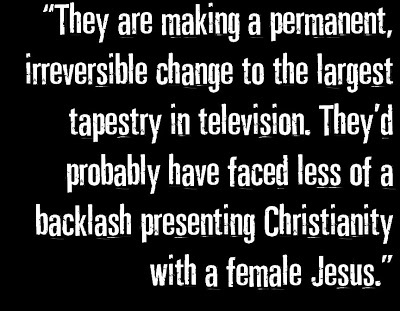 To a certain extent I was prepared for this news. I was planning to grieve for the show that I’d once loved and move on; keep quiet and let those who want to watch it and enjoy it, watch it and enjoy it. After all, nobody can make me. What has aggravated me though has been the militant chorus that has taken to social media to crow about their “victory”. These are predominantly people who’ve never had any real interest in the show or its lead character until it occurred to them that they could use it to score a few equality points in the media spotlight. They claim to have “taken” superheroes (by which they mean DC/Warner Bros have made a long-overdue Wonder Woman film); “taken” the Ghostbusters (by which they mean Sony made a reimagined Ghostbusters film with four female leads); and even “taken”
Star Wars
though the introduction of strong female protagonists in
The Force Awakens
and Rogue One (which means that they haven’t seen the other
Star Wars
movies. Carrie Fisher’s turning in her grave).
To a certain extent I was prepared for this news. I was planning to grieve for the show that I’d once loved and move on; keep quiet and let those who want to watch it and enjoy it, watch it and enjoy it. After all, nobody can make me. What has aggravated me though has been the militant chorus that has taken to social media to crow about their “victory”. These are predominantly people who’ve never had any real interest in the show or its lead character until it occurred to them that they could use it to score a few equality points in the media spotlight. They claim to have “taken” superheroes (by which they mean DC/Warner Bros have made a long-overdue Wonder Woman film); “taken” the Ghostbusters (by which they mean Sony made a reimagined Ghostbusters film with four female leads); and even “taken”
Star Wars
though the introduction of strong female protagonists in
The Force Awakens
and Rogue One (which means that they haven’t seen the other
Star Wars
movies. Carrie Fisher’s turning in her grave).
 Needless to say, I’ve welcomed all of these things, the awesome
Rogue One
in particular, but what’s markedly different, and I dare say unprecedented, here is that the female Doctor will become part of a fifty-odd-year-old canon.
Rogue One
doesn’t stick a pair of tits on Luke and Han, or a cock on Leia for that matter. Rather, it introduces a new principal character who happens to be female. Ghostbusters doesn’t see Egon Spengler and company castrated and given HRT - it creates four new female ’Busters. Wonder Woman, as you might have guessed, is based on a character that is - and has always been - female and has always “belonged” as much to women as she has men. Here though, Chris Chibnall and his incoming production team aren’t merely mounting a remake or introducing a new female character. They are making a permanent, irreversible change to the largest tapestry in television; a tapestry treated by some with great – albeit probably undue - reverence. They’d probably have faced less of a backlash presenting Christianity with a female Jesus to venerate from hereon in.
Needless to say, I’ve welcomed all of these things, the awesome
Rogue One
in particular, but what’s markedly different, and I dare say unprecedented, here is that the female Doctor will become part of a fifty-odd-year-old canon.
Rogue One
doesn’t stick a pair of tits on Luke and Han, or a cock on Leia for that matter. Rather, it introduces a new principal character who happens to be female. Ghostbusters doesn’t see Egon Spengler and company castrated and given HRT - it creates four new female ’Busters. Wonder Woman, as you might have guessed, is based on a character that is - and has always been - female and has always “belonged” as much to women as she has men. Here though, Chris Chibnall and his incoming production team aren’t merely mounting a remake or introducing a new female character. They are making a permanent, irreversible change to the largest tapestry in television; a tapestry treated by some with great – albeit probably undue - reverence. They’d probably have faced less of a backlash presenting Christianity with a female Jesus to venerate from hereon in.
And woe betides any long-standing fan who’s openly taken umbrage with the casting, particularly if they are male – they are immediately and aggressively shot down in flames as sexists and misogynists. But objecting to suddenly having one’s hero become transgender is not sexism. It’s not chauvinism. It’s not misogyny. It was eminently foreseeable that those who’ve identified with an iconic character for years, some of whom helped to keep Doctor Who alive in the sixteen years that it was off air through purchasing countless books and audio dramas, would feel betrayed and be saddened by their hero’s gender swap. It doesn’t mean that they don’t respect and admire strong female characters both in and out of the Whoniverse – hell, Supergirl is one of my favourite TV series at the moment – it just means that they don’t like the idea of their favourite hero becoming one.

As I went through in my post yesterday, however much we might protest about how Gallifreyan gender and regeneration were portrayed prior to Steven Moffat’s time at the series’ helm, Doctor Who is science fiction and so, with a little technical jiggery-pokery, a gender swap – like anything - can be made to work on a plot level. Of course, that doesn’t make it the right thing to do. I can’t categorically say that it is the wrong thing to do – all I know for sure is that, rightly or wrongly, I have absolutely no interest in watching a female Doctor, or indeed any of the fluid-gender Doctors that may succeed her (assuming that the series survives the next few years). For someone who used to love the show as much as I did, that’s very sad.

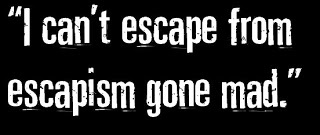 I’d hoped that at least my feminist sister and eldest daughter, both of whom love the programme (my eldest daughter even spent the better part of June making a talking Dalek scarecrow alongside the Mr Men’s fourth Doctor), would be pleased, but my deflated sister just texted me a single word -“Gutted” - and when I told my little girl the news, she cried. Actually cried. I wished I’d have filmed it. “But he’s a boy. That’s silly!” she shouted, stomping her right foot theatrically, as young children are prone to when irate. “That’s really, really, really silly!” Cue tears. And just like that, there goes my silver living.
I’d hoped that at least my feminist sister and eldest daughter, both of whom love the programme (my eldest daughter even spent the better part of June making a talking Dalek scarecrow alongside the Mr Men’s fourth Doctor), would be pleased, but my deflated sister just texted me a single word -“Gutted” - and when I told my little girl the news, she cried. Actually cried. I wished I’d have filmed it. “But he’s a boy. That’s silly!” she shouted, stomping her right foot theatrically, as young children are prone to when irate. “That’s really, really, really silly!” Cue tears. And just like that, there goes my silver living.

Out of all of this though, one thing does make me smile – the outspoken young man who in the mid-1980s took to television to lambaste what he felt was the declining quality of the series has now inherited it in its worst state since that date, give or take a year, and then made a creative decision that could kill it beyond its capacity to regenerate. If nothing else, that’s ironic.
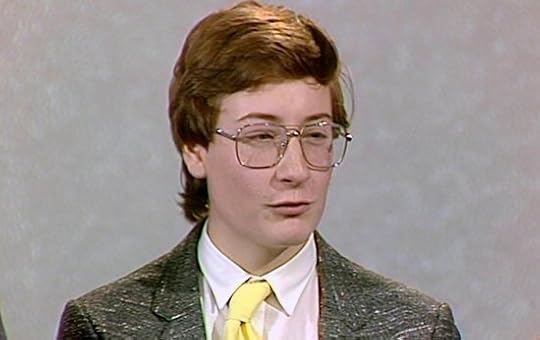
As such, I’ve taken The History of the Doctor down – it only serves as a painful reminder of the rich history that’s now been lost. Fortunately the Whoniverse is a big place and Big Finish Productions will continue to produce adventures for the Doctor’s first thirteen incarnations long into the future, so there’s plenty of new stories out there to enjoy should I ever feel the pull of the Whoniverse again. Right now though, I just feel like sitting with my head in my hands – as if terrorism, Trump, Brexit and potentially five more years of austerity weren’t enough for one calendar year, now I can’t even escape from escapism gone mad.

 To a certain extent I was prepared for this news. I was planning to grieve for the show that I’d once loved and move on; keep quiet and let those who want to watch it and enjoy it, watch it and enjoy it. After all, nobody can make me. What has aggravated me though has been the militant chorus that has taken to social media to crow about their “victory”. These are predominantly people who’ve never had any real interest in the show or its lead character until it occurred to them that they could use it to score a few equality points in the media spotlight. They claim to have “taken” superheroes (by which they mean DC/Warner Bros have made a long-overdue Wonder Woman film); “taken” the Ghostbusters (by which they mean Sony made a reimagined Ghostbusters film with four female leads); and even “taken”
Star Wars
though the introduction of strong female protagonists in
The Force Awakens
and Rogue One (which means that they haven’t seen the other
Star Wars
movies. Carrie Fisher’s turning in her grave).
To a certain extent I was prepared for this news. I was planning to grieve for the show that I’d once loved and move on; keep quiet and let those who want to watch it and enjoy it, watch it and enjoy it. After all, nobody can make me. What has aggravated me though has been the militant chorus that has taken to social media to crow about their “victory”. These are predominantly people who’ve never had any real interest in the show or its lead character until it occurred to them that they could use it to score a few equality points in the media spotlight. They claim to have “taken” superheroes (by which they mean DC/Warner Bros have made a long-overdue Wonder Woman film); “taken” the Ghostbusters (by which they mean Sony made a reimagined Ghostbusters film with four female leads); and even “taken”
Star Wars
though the introduction of strong female protagonists in
The Force Awakens
and Rogue One (which means that they haven’t seen the other
Star Wars
movies. Carrie Fisher’s turning in her grave).  Needless to say, I’ve welcomed all of these things, the awesome
Rogue One
in particular, but what’s markedly different, and I dare say unprecedented, here is that the female Doctor will become part of a fifty-odd-year-old canon.
Rogue One
doesn’t stick a pair of tits on Luke and Han, or a cock on Leia for that matter. Rather, it introduces a new principal character who happens to be female. Ghostbusters doesn’t see Egon Spengler and company castrated and given HRT - it creates four new female ’Busters. Wonder Woman, as you might have guessed, is based on a character that is - and has always been - female and has always “belonged” as much to women as she has men. Here though, Chris Chibnall and his incoming production team aren’t merely mounting a remake or introducing a new female character. They are making a permanent, irreversible change to the largest tapestry in television; a tapestry treated by some with great – albeit probably undue - reverence. They’d probably have faced less of a backlash presenting Christianity with a female Jesus to venerate from hereon in.
Needless to say, I’ve welcomed all of these things, the awesome
Rogue One
in particular, but what’s markedly different, and I dare say unprecedented, here is that the female Doctor will become part of a fifty-odd-year-old canon.
Rogue One
doesn’t stick a pair of tits on Luke and Han, or a cock on Leia for that matter. Rather, it introduces a new principal character who happens to be female. Ghostbusters doesn’t see Egon Spengler and company castrated and given HRT - it creates four new female ’Busters. Wonder Woman, as you might have guessed, is based on a character that is - and has always been - female and has always “belonged” as much to women as she has men. Here though, Chris Chibnall and his incoming production team aren’t merely mounting a remake or introducing a new female character. They are making a permanent, irreversible change to the largest tapestry in television; a tapestry treated by some with great – albeit probably undue - reverence. They’d probably have faced less of a backlash presenting Christianity with a female Jesus to venerate from hereon in. And woe betides any long-standing fan who’s openly taken umbrage with the casting, particularly if they are male – they are immediately and aggressively shot down in flames as sexists and misogynists. But objecting to suddenly having one’s hero become transgender is not sexism. It’s not chauvinism. It’s not misogyny. It was eminently foreseeable that those who’ve identified with an iconic character for years, some of whom helped to keep Doctor Who alive in the sixteen years that it was off air through purchasing countless books and audio dramas, would feel betrayed and be saddened by their hero’s gender swap. It doesn’t mean that they don’t respect and admire strong female characters both in and out of the Whoniverse – hell, Supergirl is one of my favourite TV series at the moment – it just means that they don’t like the idea of their favourite hero becoming one.

As I went through in my post yesterday, however much we might protest about how Gallifreyan gender and regeneration were portrayed prior to Steven Moffat’s time at the series’ helm, Doctor Who is science fiction and so, with a little technical jiggery-pokery, a gender swap – like anything - can be made to work on a plot level. Of course, that doesn’t make it the right thing to do. I can’t categorically say that it is the wrong thing to do – all I know for sure is that, rightly or wrongly, I have absolutely no interest in watching a female Doctor, or indeed any of the fluid-gender Doctors that may succeed her (assuming that the series survives the next few years). For someone who used to love the show as much as I did, that’s very sad.

 I’d hoped that at least my feminist sister and eldest daughter, both of whom love the programme (my eldest daughter even spent the better part of June making a talking Dalek scarecrow alongside the Mr Men’s fourth Doctor), would be pleased, but my deflated sister just texted me a single word -“Gutted” - and when I told my little girl the news, she cried. Actually cried. I wished I’d have filmed it. “But he’s a boy. That’s silly!” she shouted, stomping her right foot theatrically, as young children are prone to when irate. “That’s really, really, really silly!” Cue tears. And just like that, there goes my silver living.
I’d hoped that at least my feminist sister and eldest daughter, both of whom love the programme (my eldest daughter even spent the better part of June making a talking Dalek scarecrow alongside the Mr Men’s fourth Doctor), would be pleased, but my deflated sister just texted me a single word -“Gutted” - and when I told my little girl the news, she cried. Actually cried. I wished I’d have filmed it. “But he’s a boy. That’s silly!” she shouted, stomping her right foot theatrically, as young children are prone to when irate. “That’s really, really, really silly!” Cue tears. And just like that, there goes my silver living.
Out of all of this though, one thing does make me smile – the outspoken young man who in the mid-1980s took to television to lambaste what he felt was the declining quality of the series has now inherited it in its worst state since that date, give or take a year, and then made a creative decision that could kill it beyond its capacity to regenerate. If nothing else, that’s ironic.

As such, I’ve taken The History of the Doctor down – it only serves as a painful reminder of the rich history that’s now been lost. Fortunately the Whoniverse is a big place and Big Finish Productions will continue to produce adventures for the Doctor’s first thirteen incarnations long into the future, so there’s plenty of new stories out there to enjoy should I ever feel the pull of the Whoniverse again. Right now though, I just feel like sitting with my head in my hands – as if terrorism, Trump, Brexit and potentially five more years of austerity weren’t enough for one calendar year, now I can’t even escape from escapism gone mad.
Published on July 17, 2017 12:08
E.G. Wolverson's Blog
- E.G. Wolverson's profile
- 52 followers
E.G. Wolverson isn't a Goodreads Author
(yet),
but they
do have a blog,
so here are some recent posts imported from
their feed.



